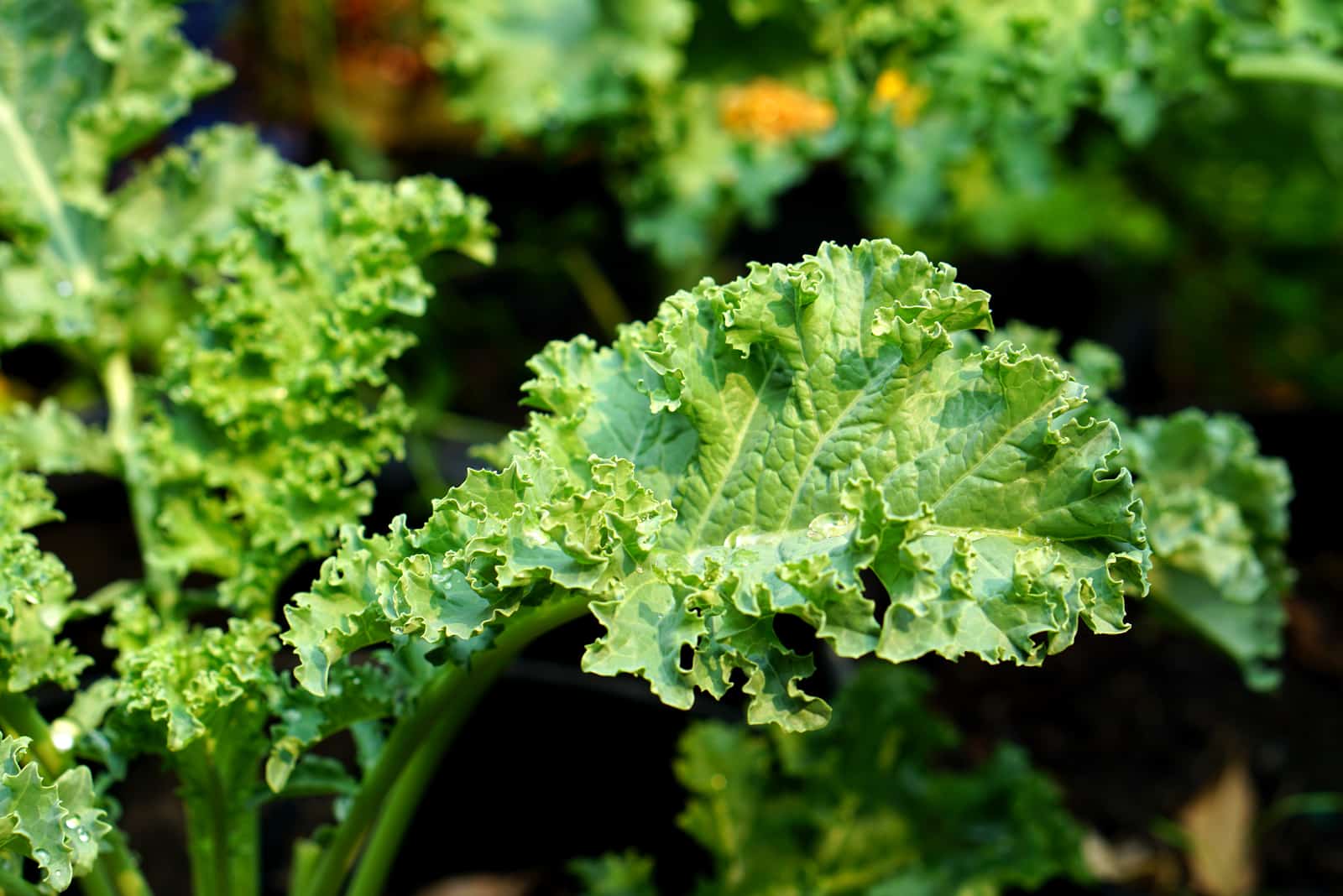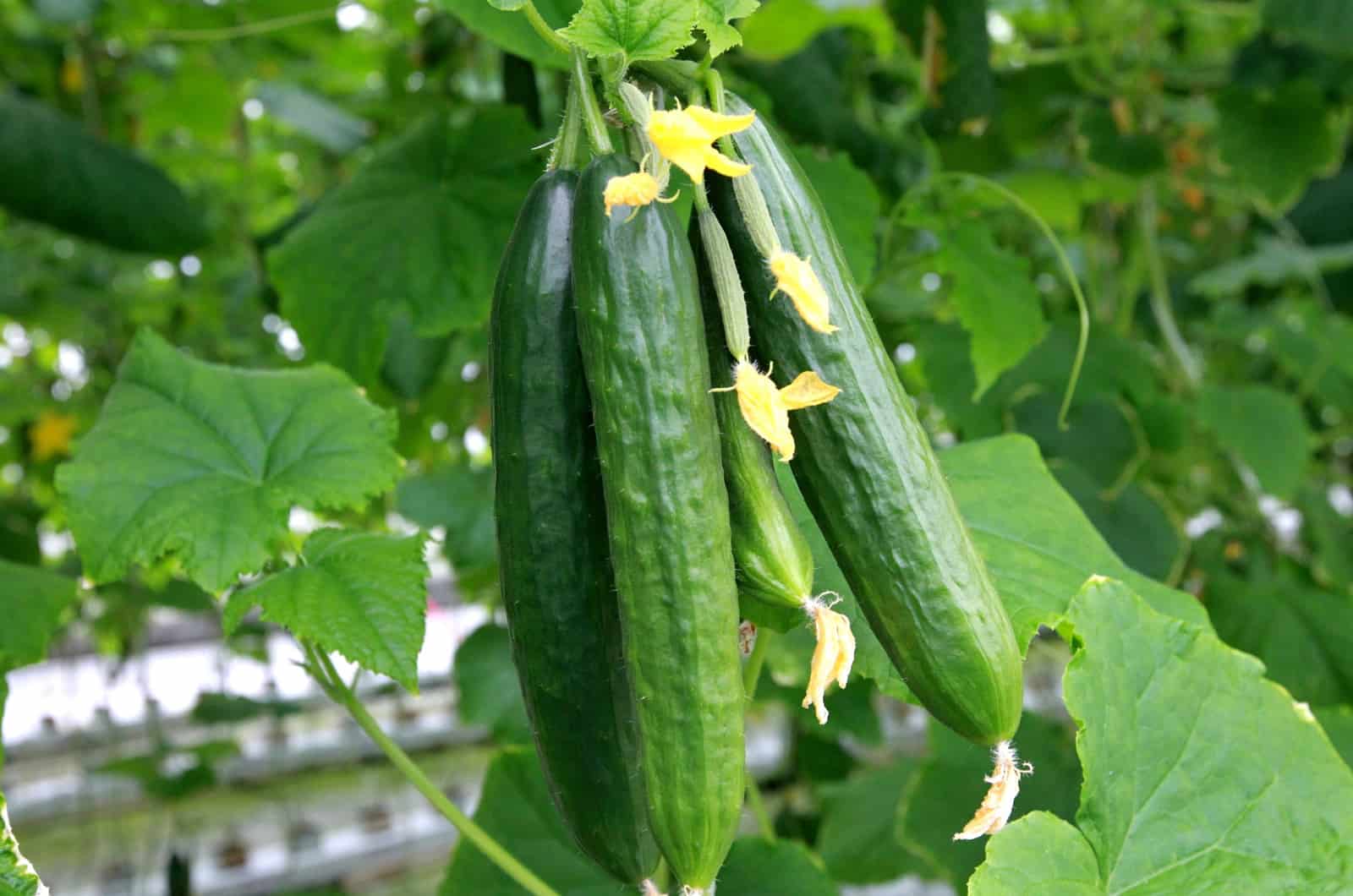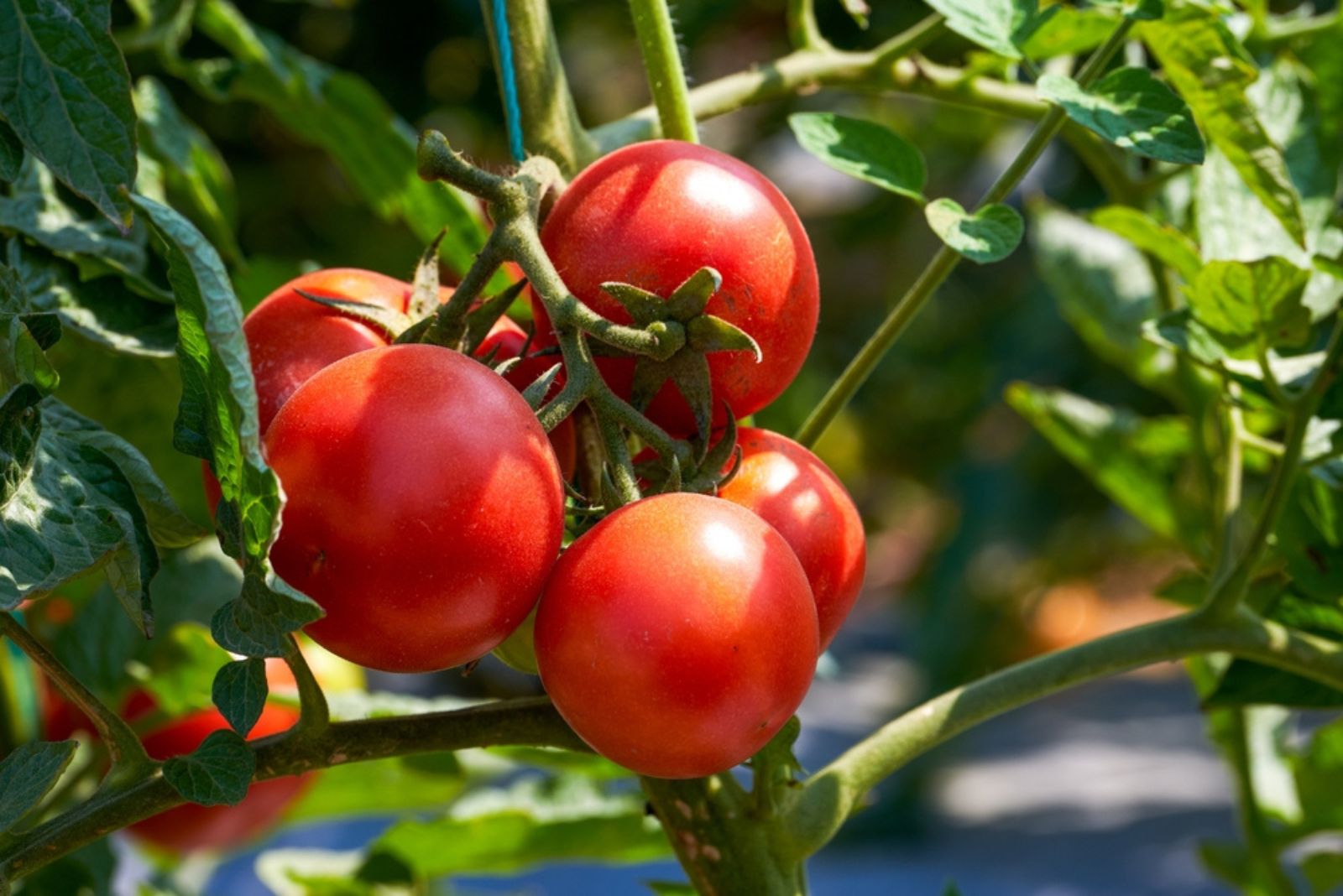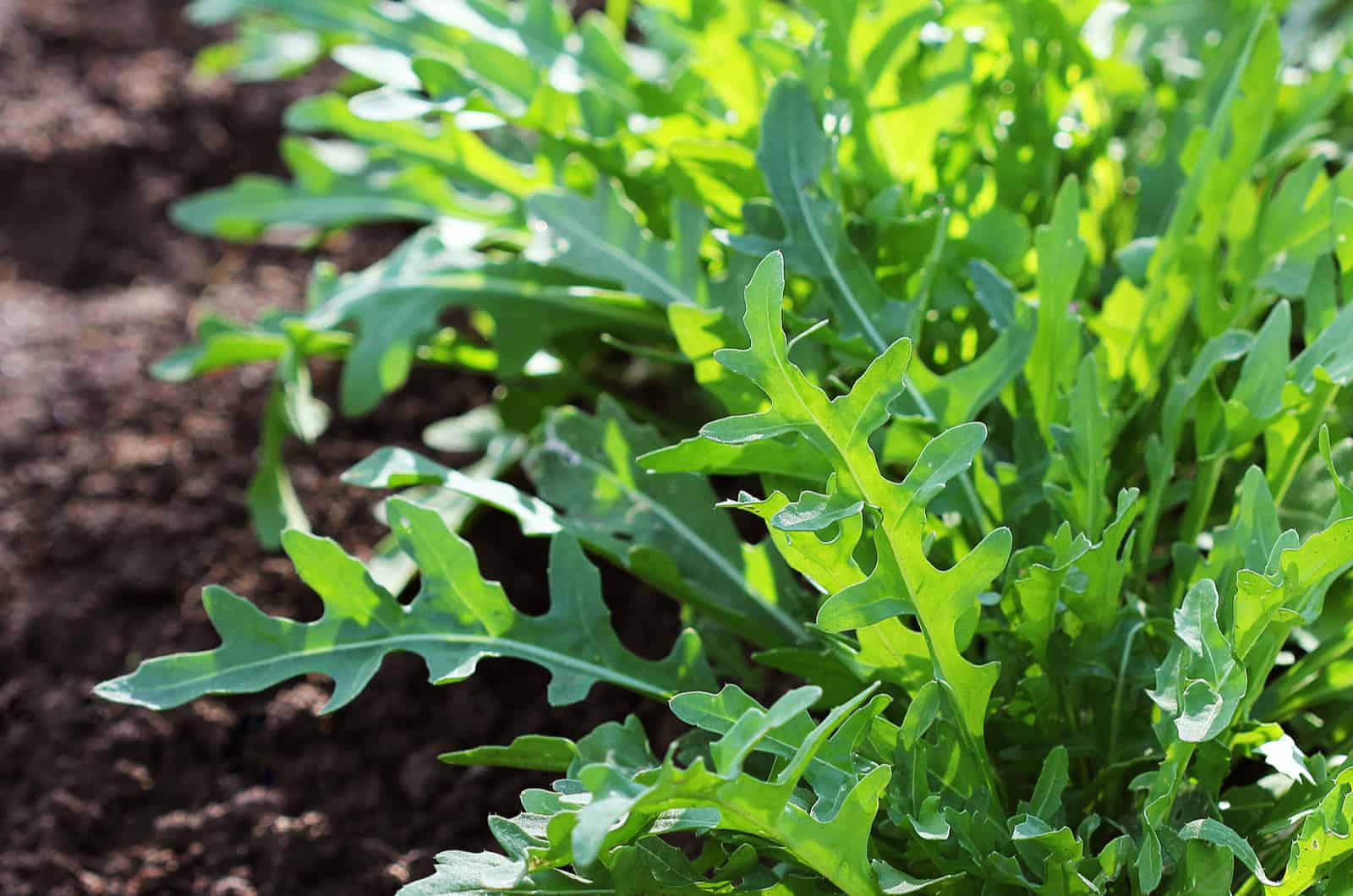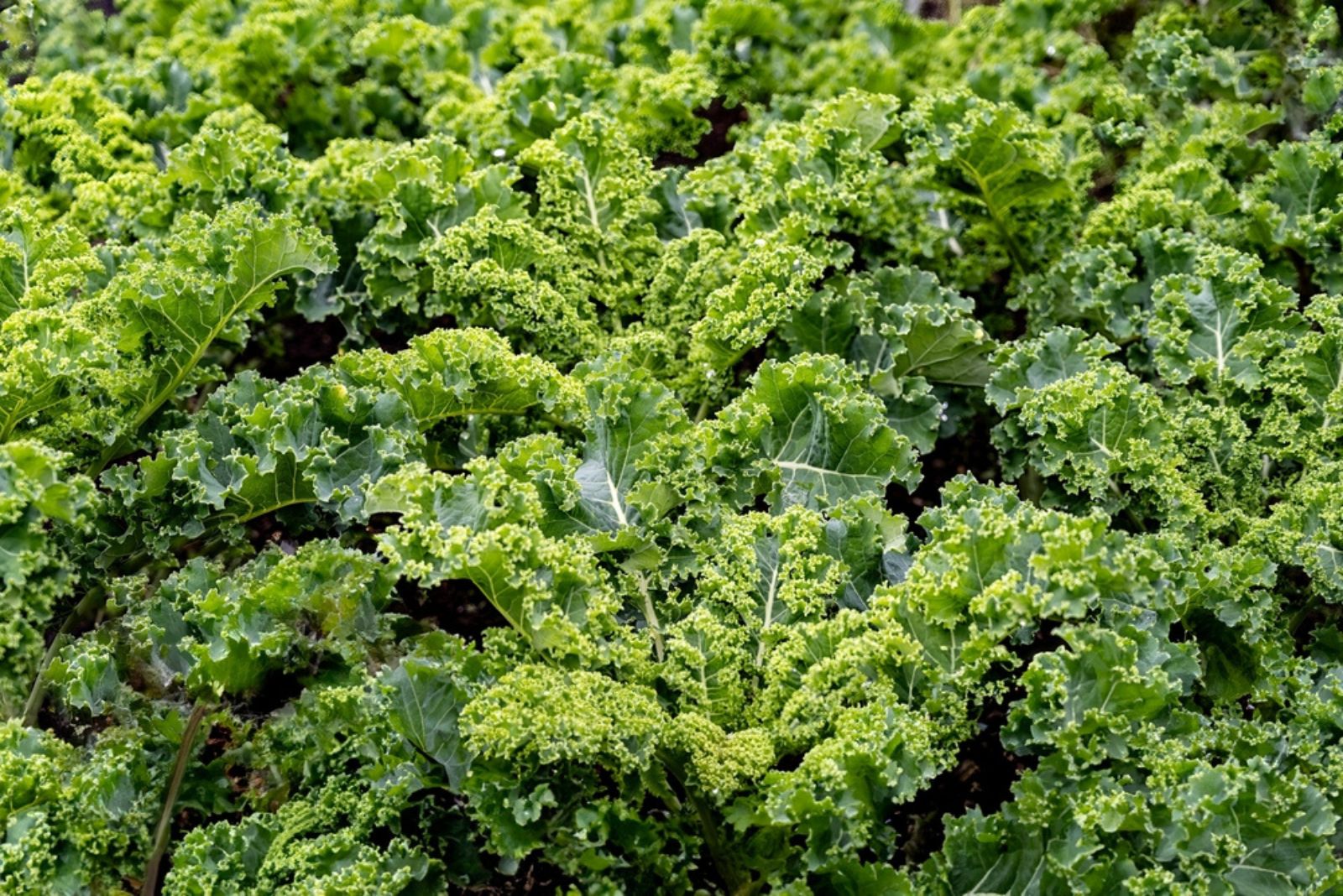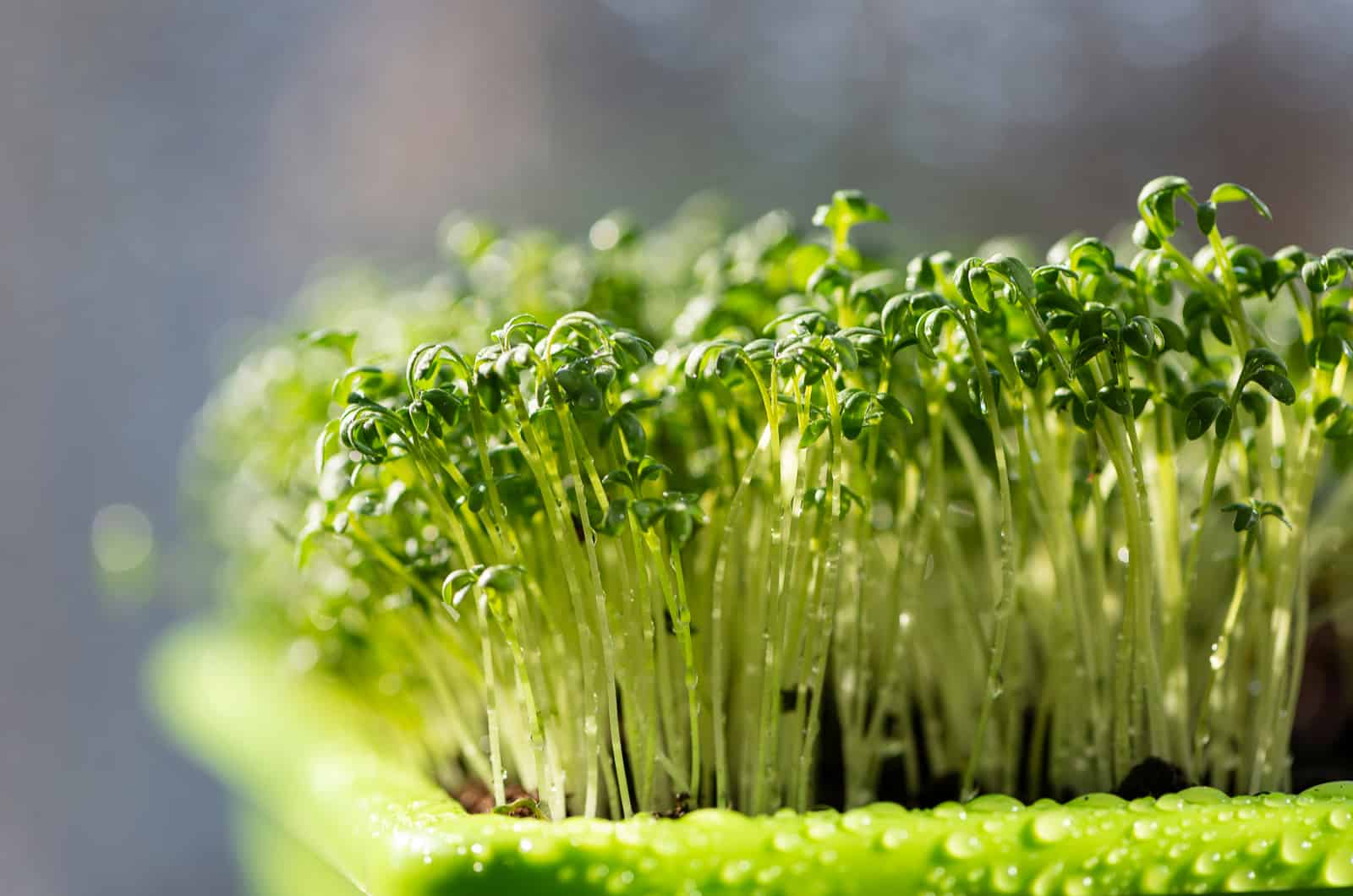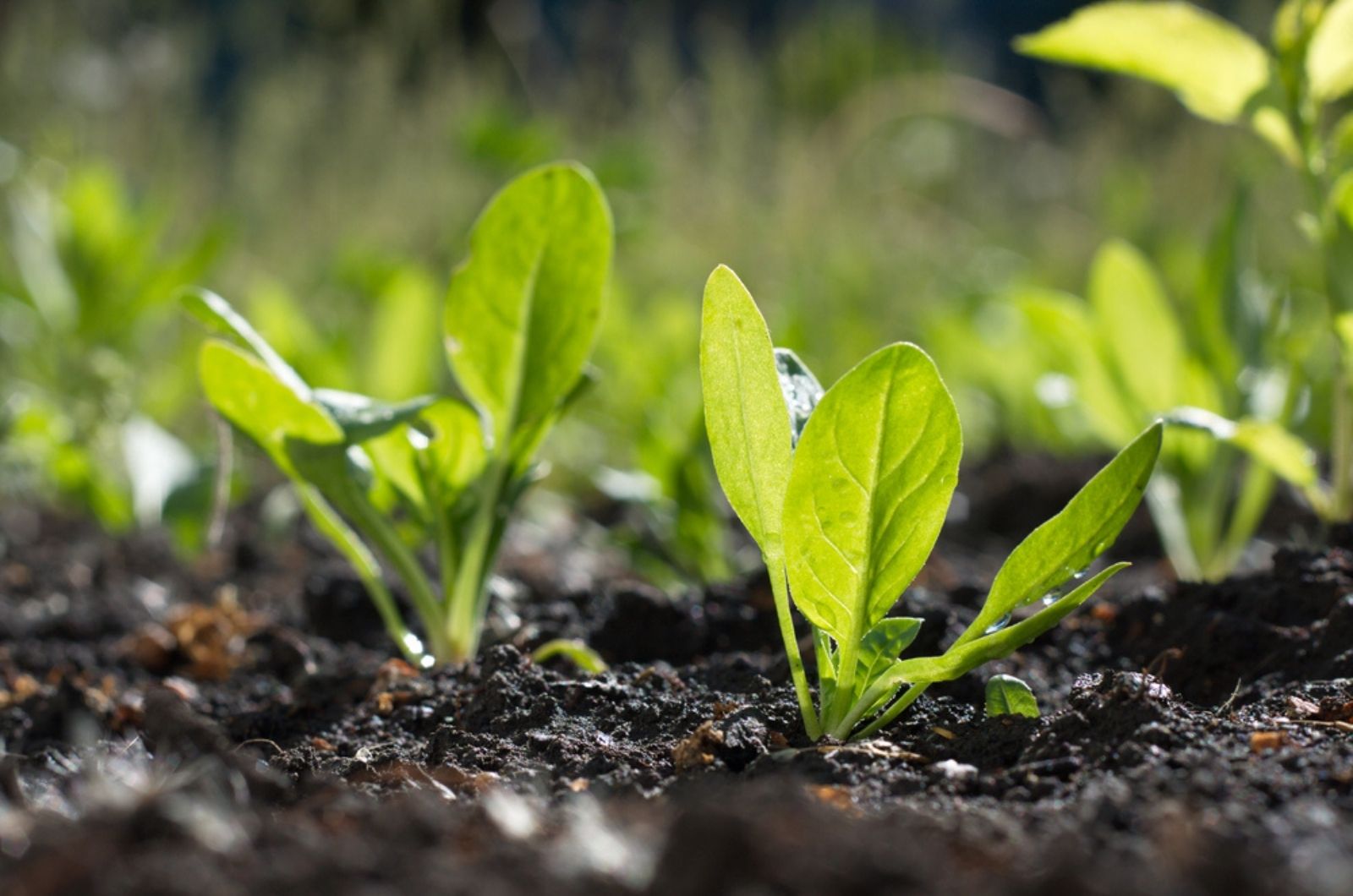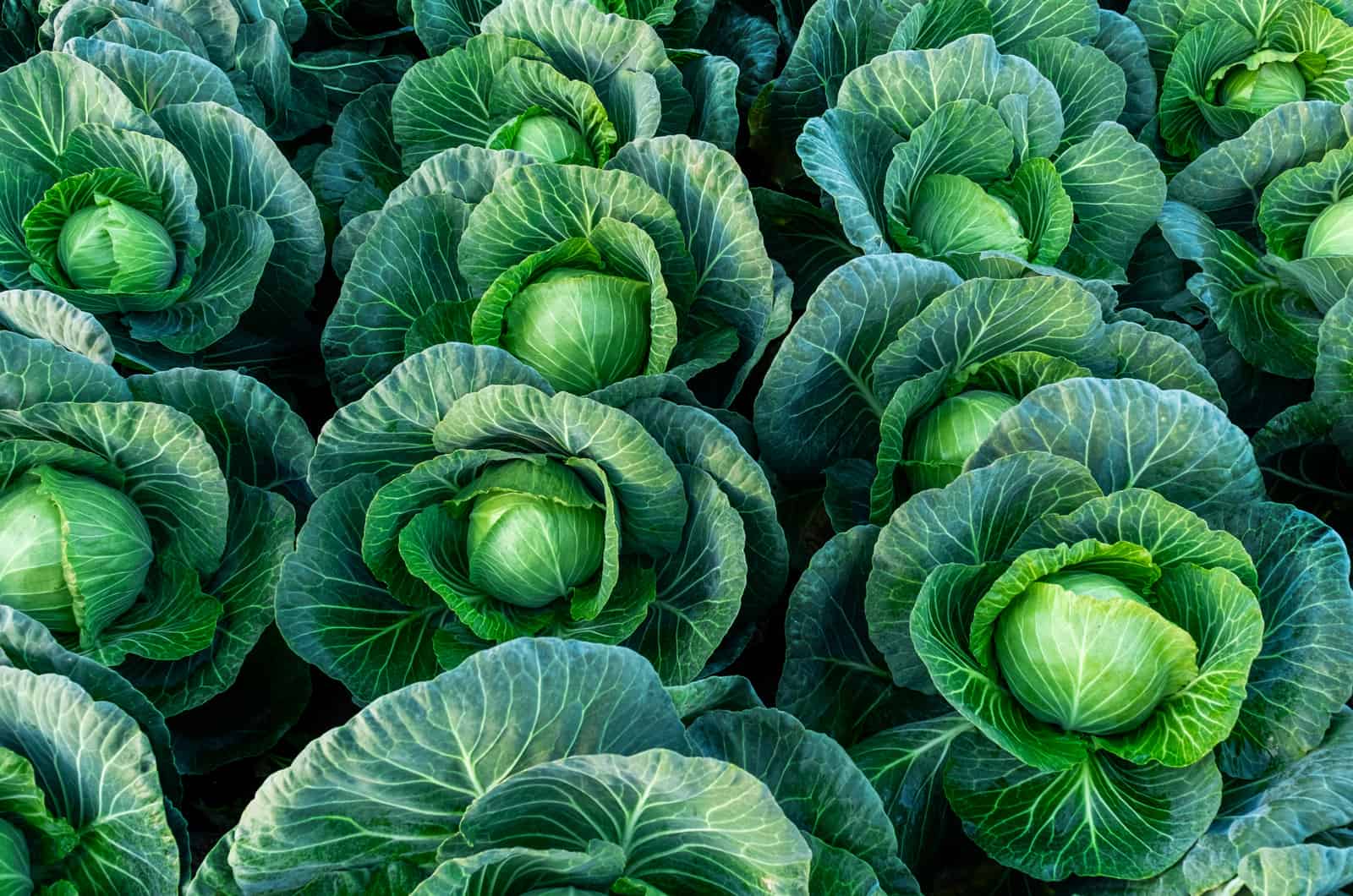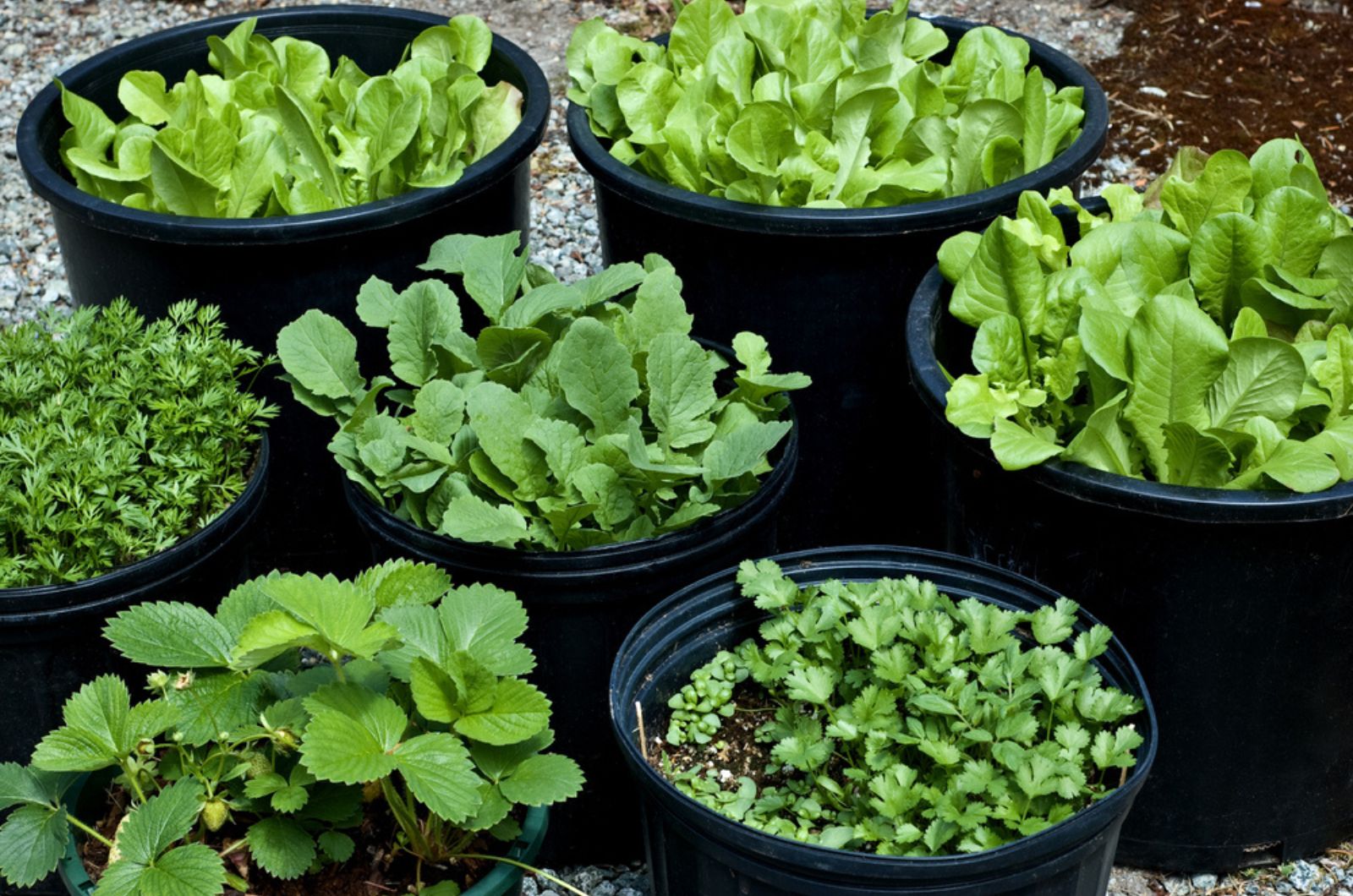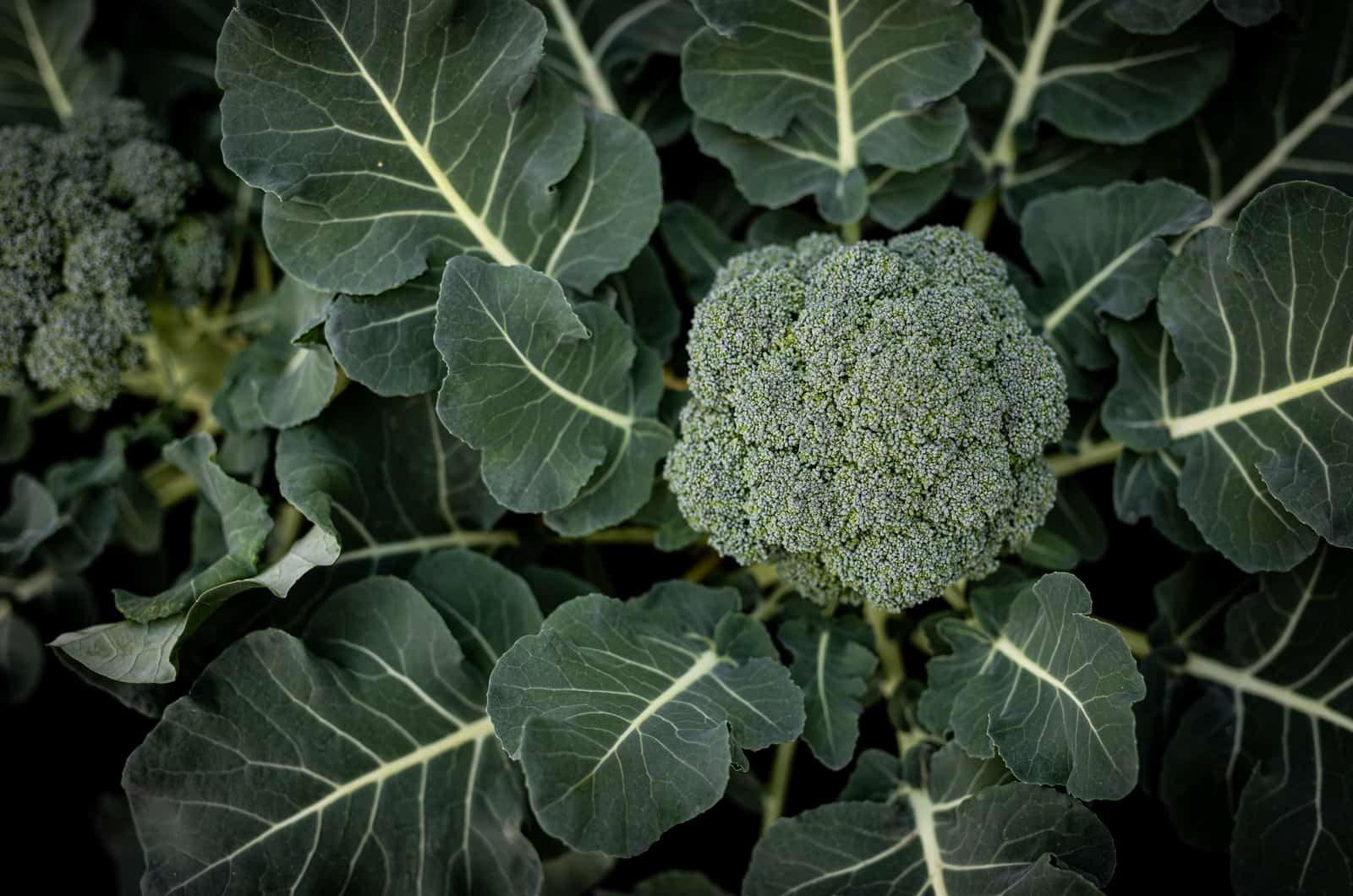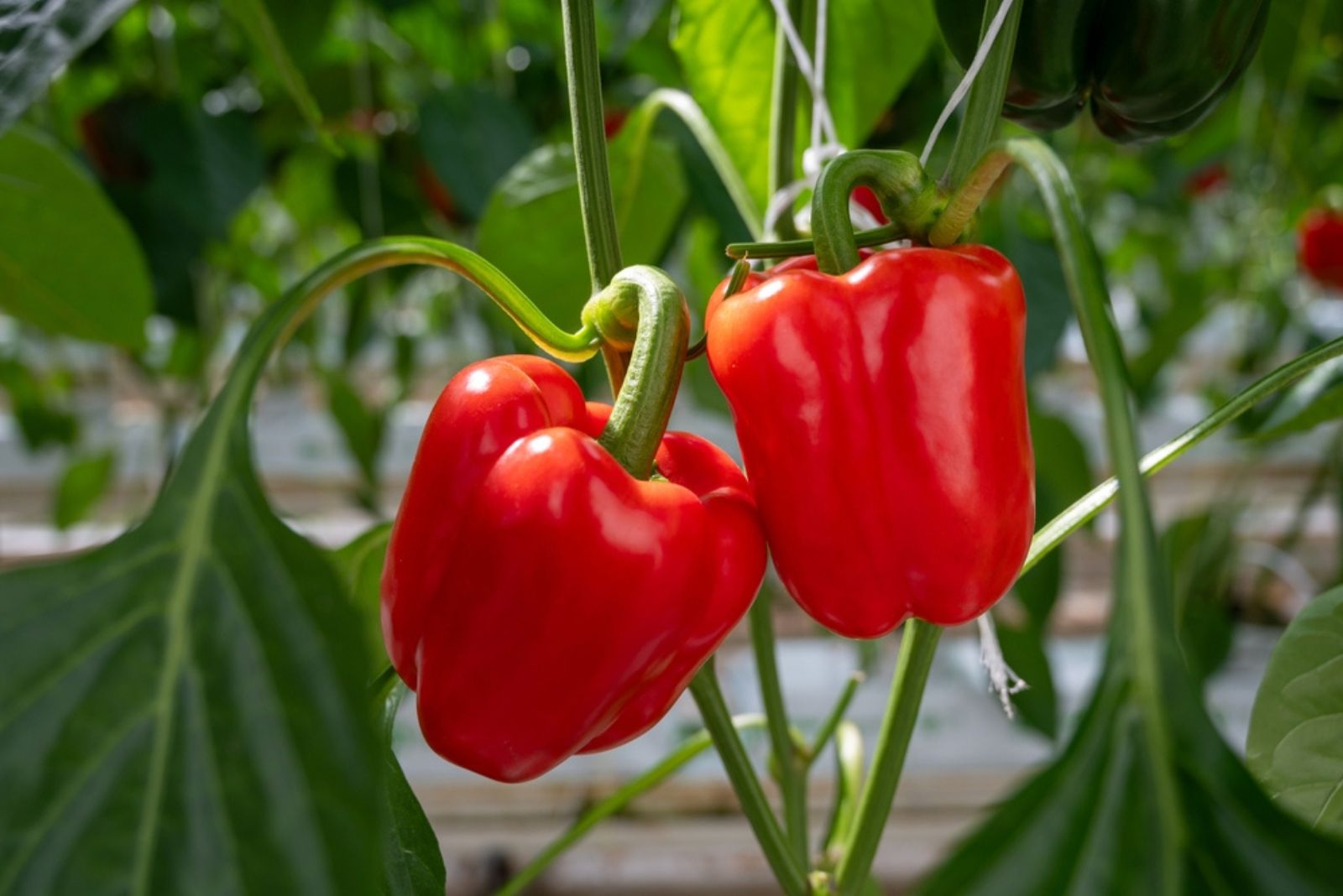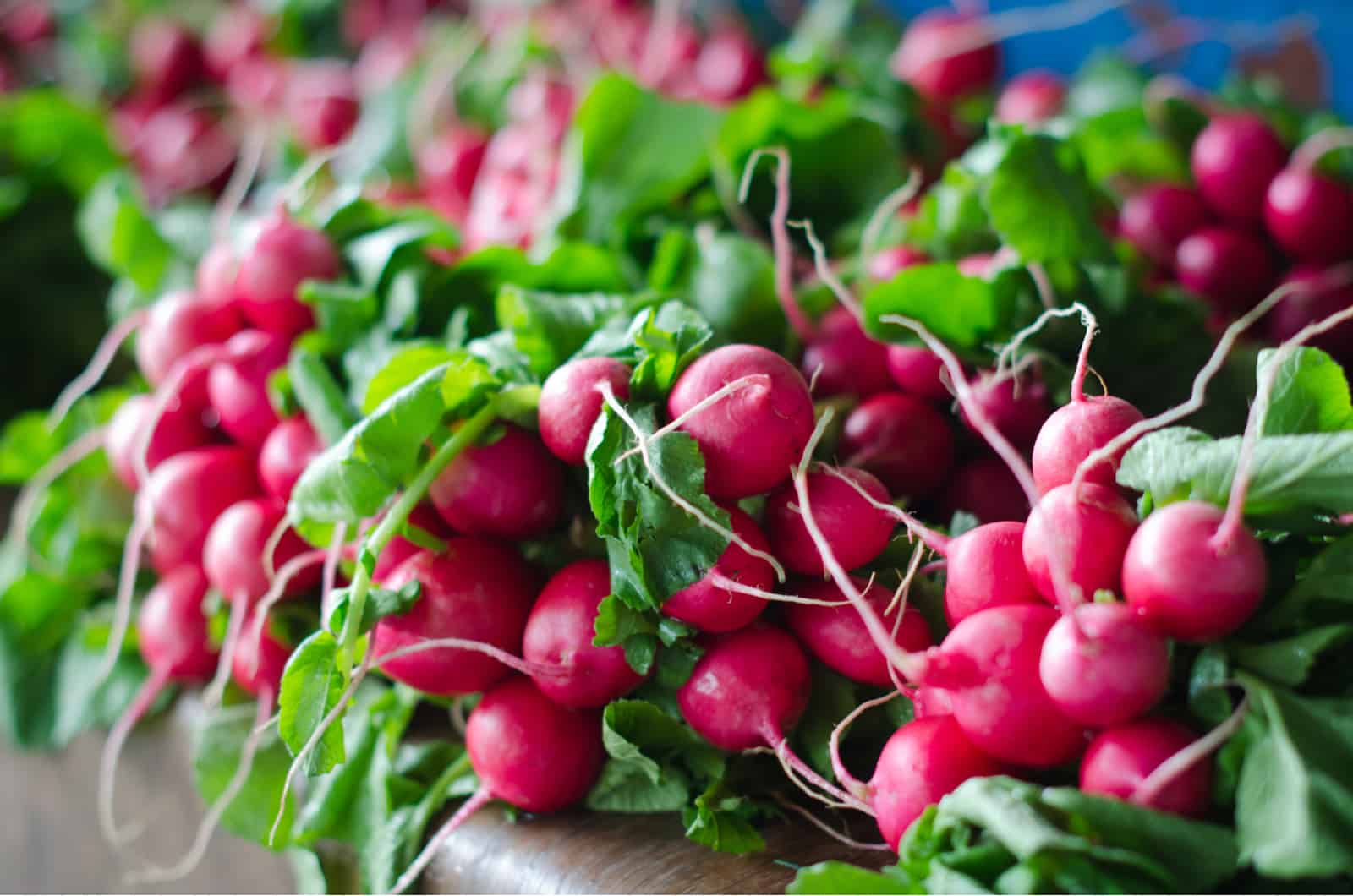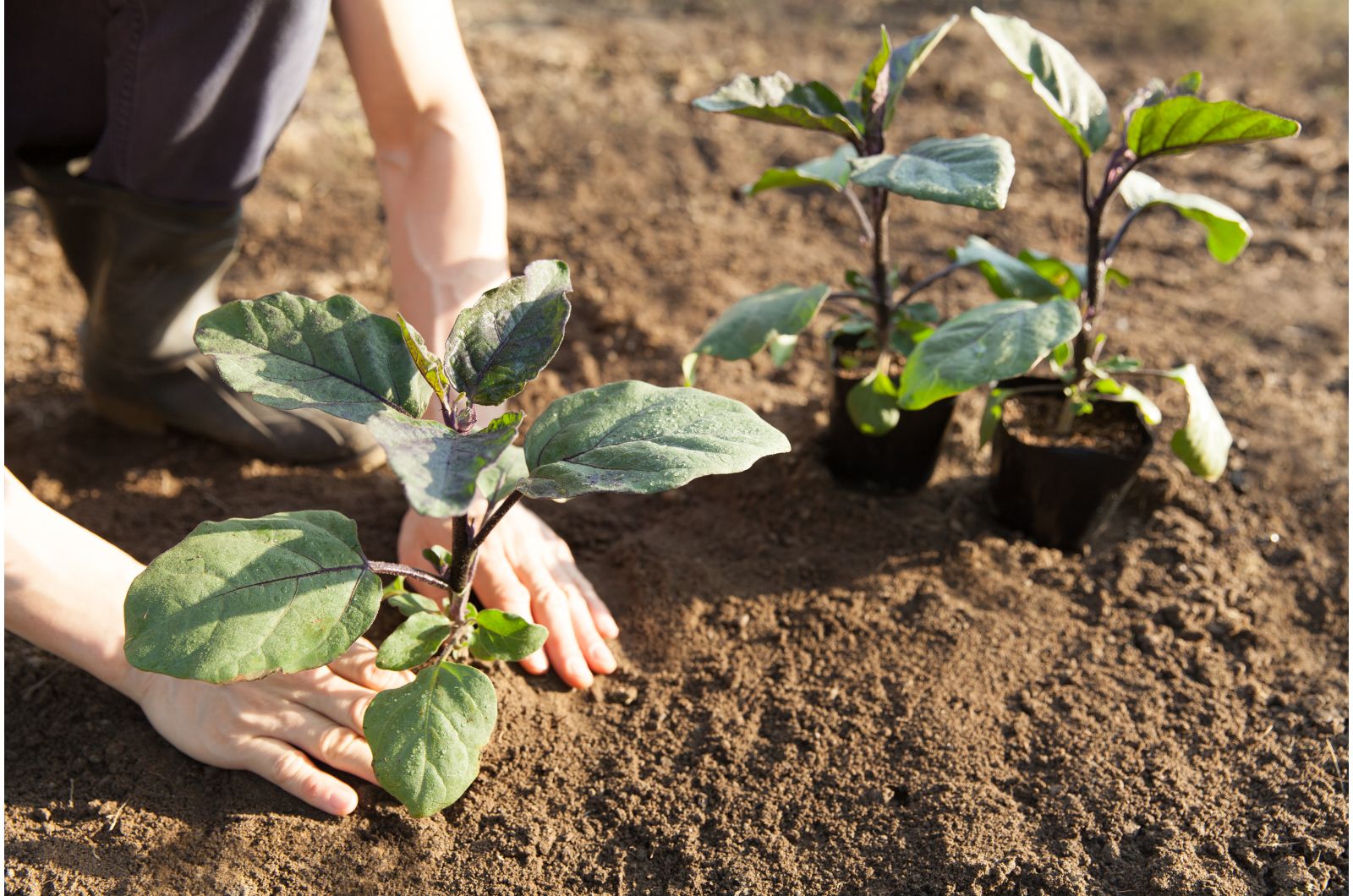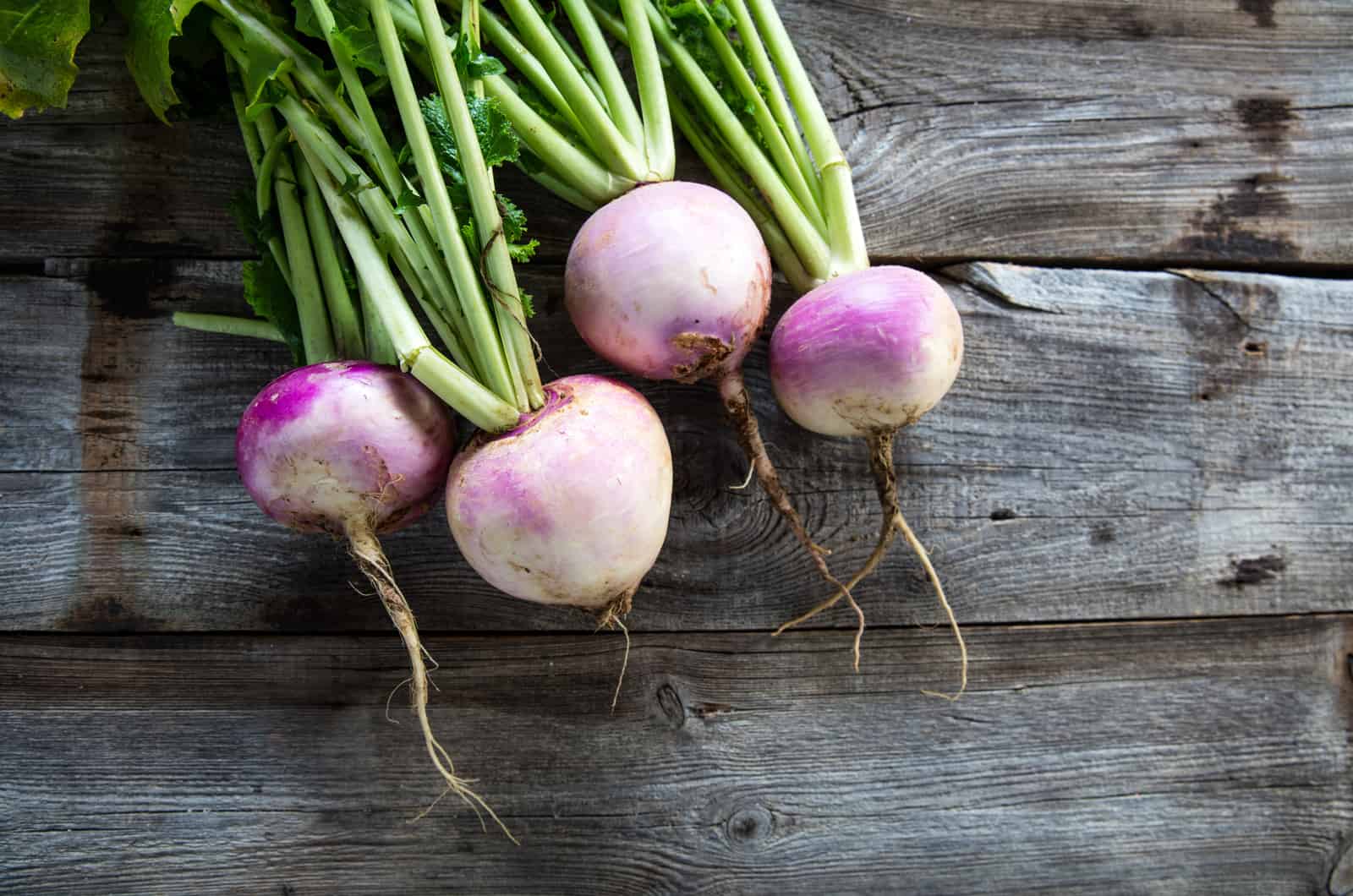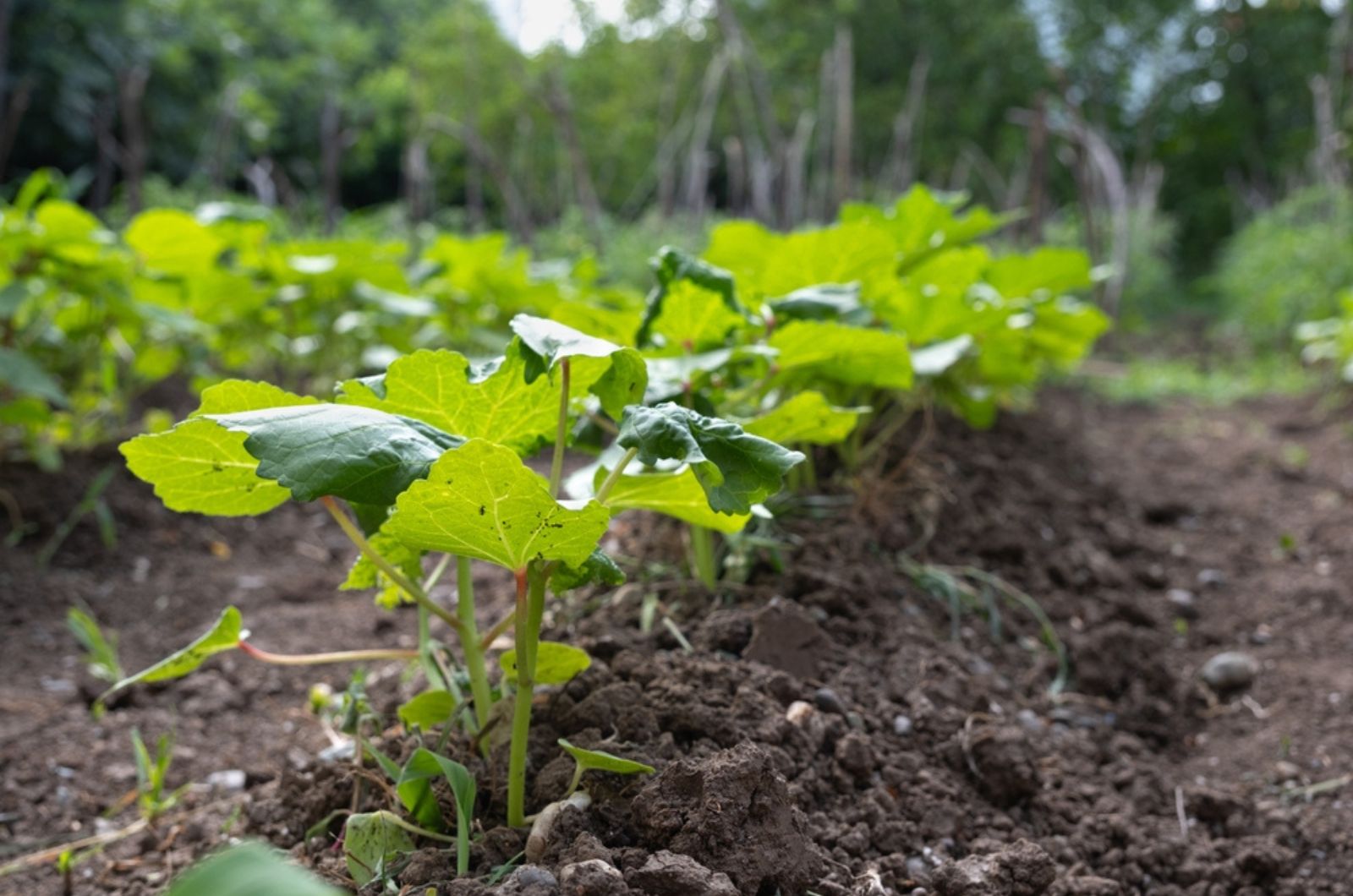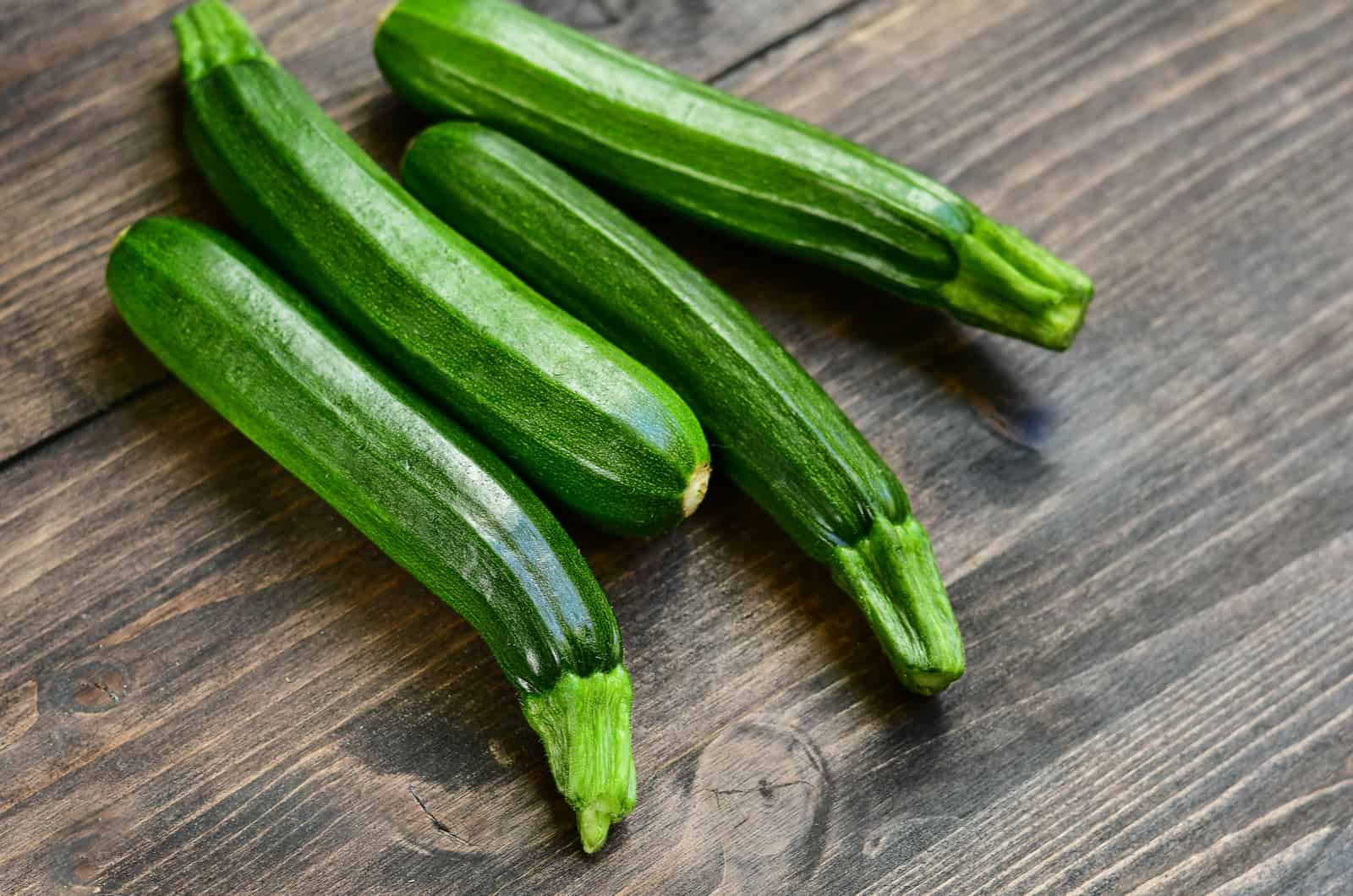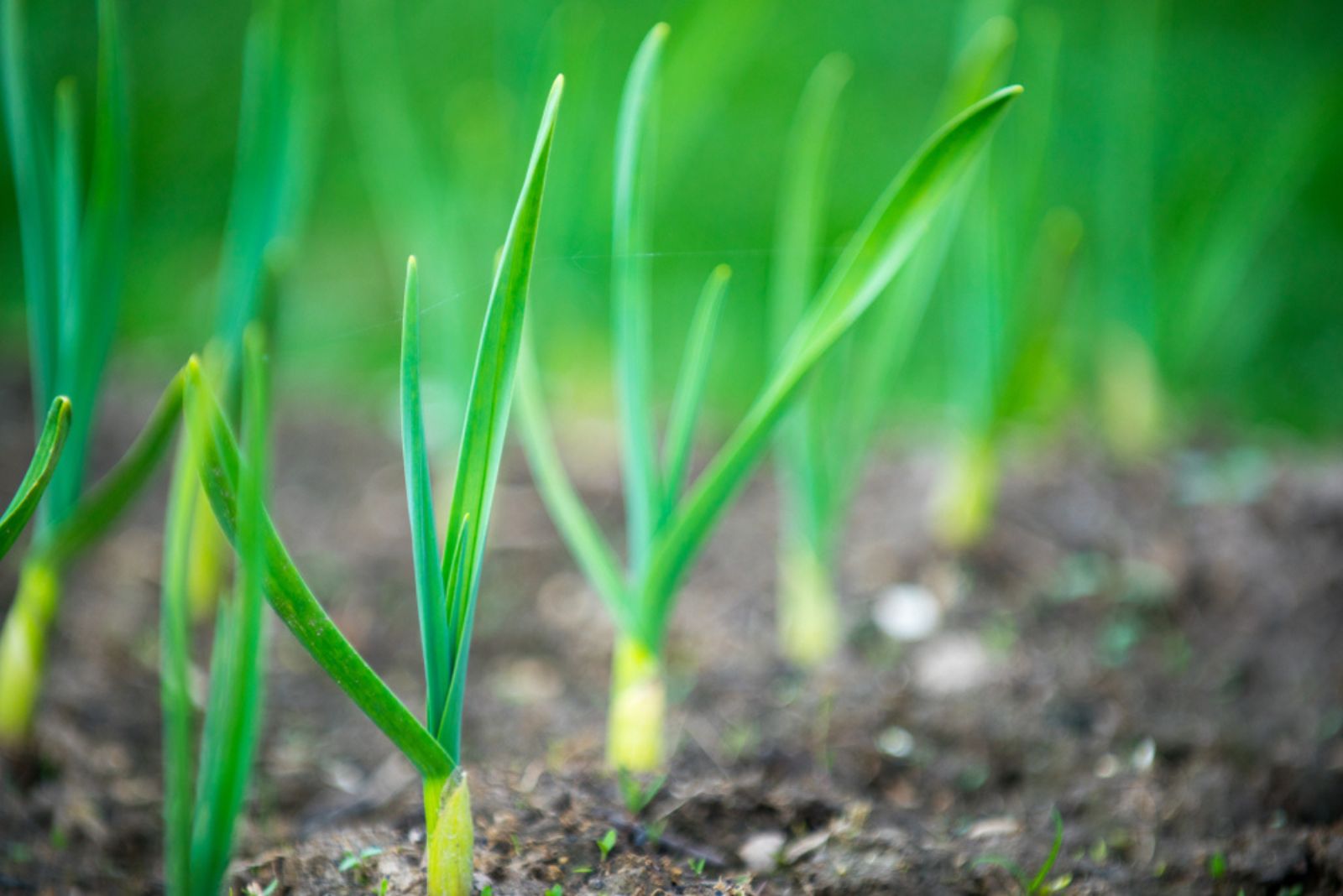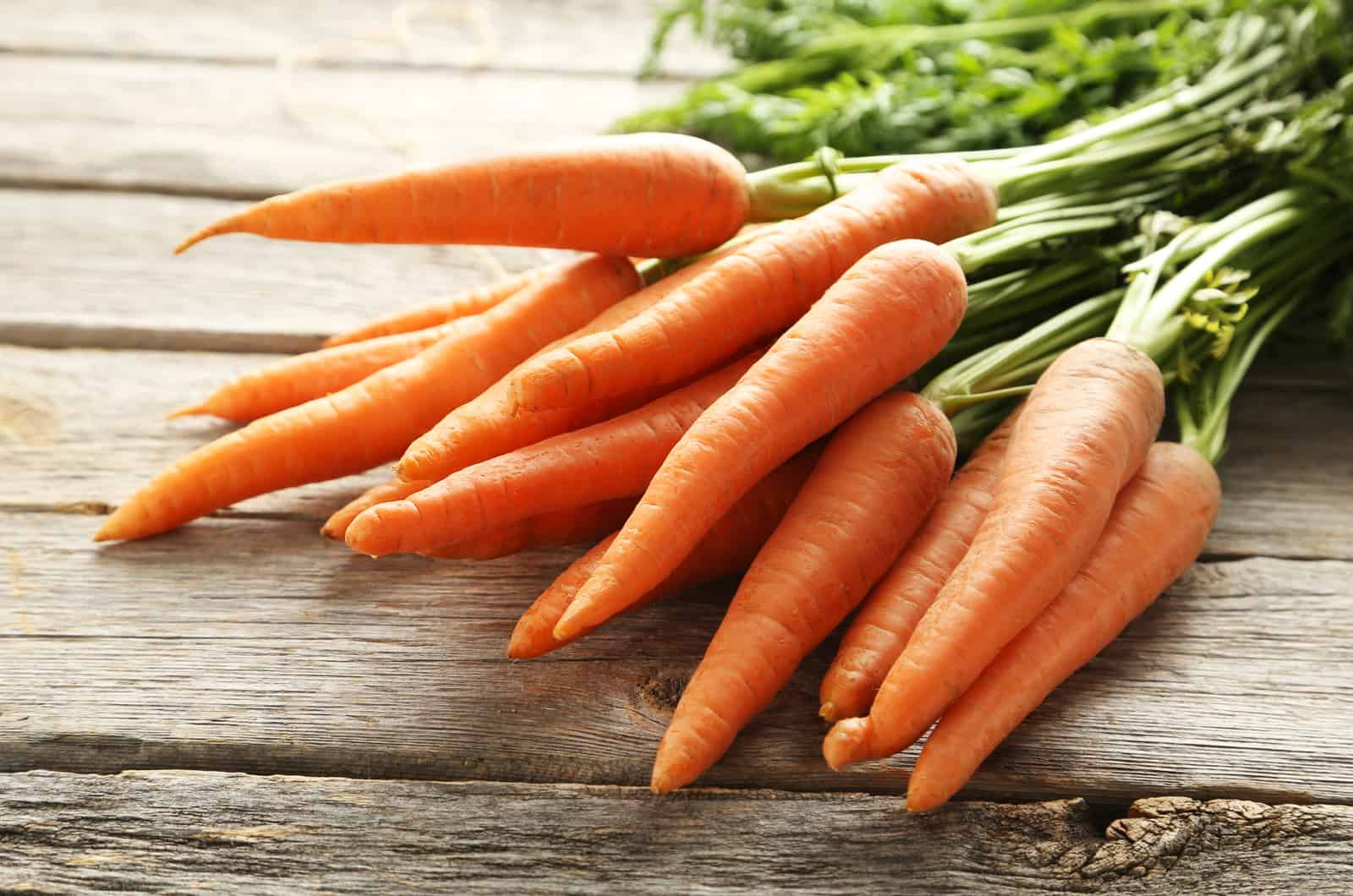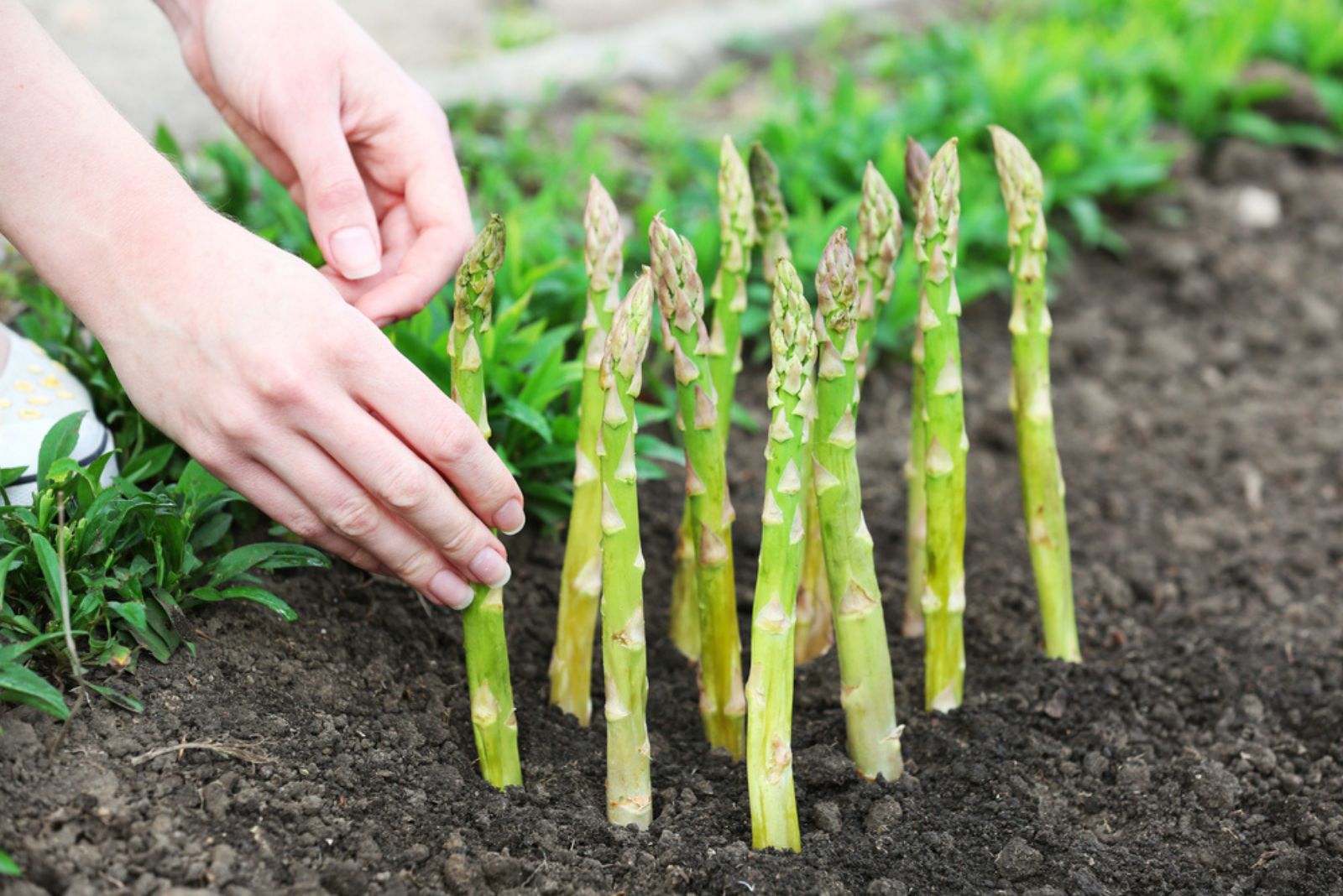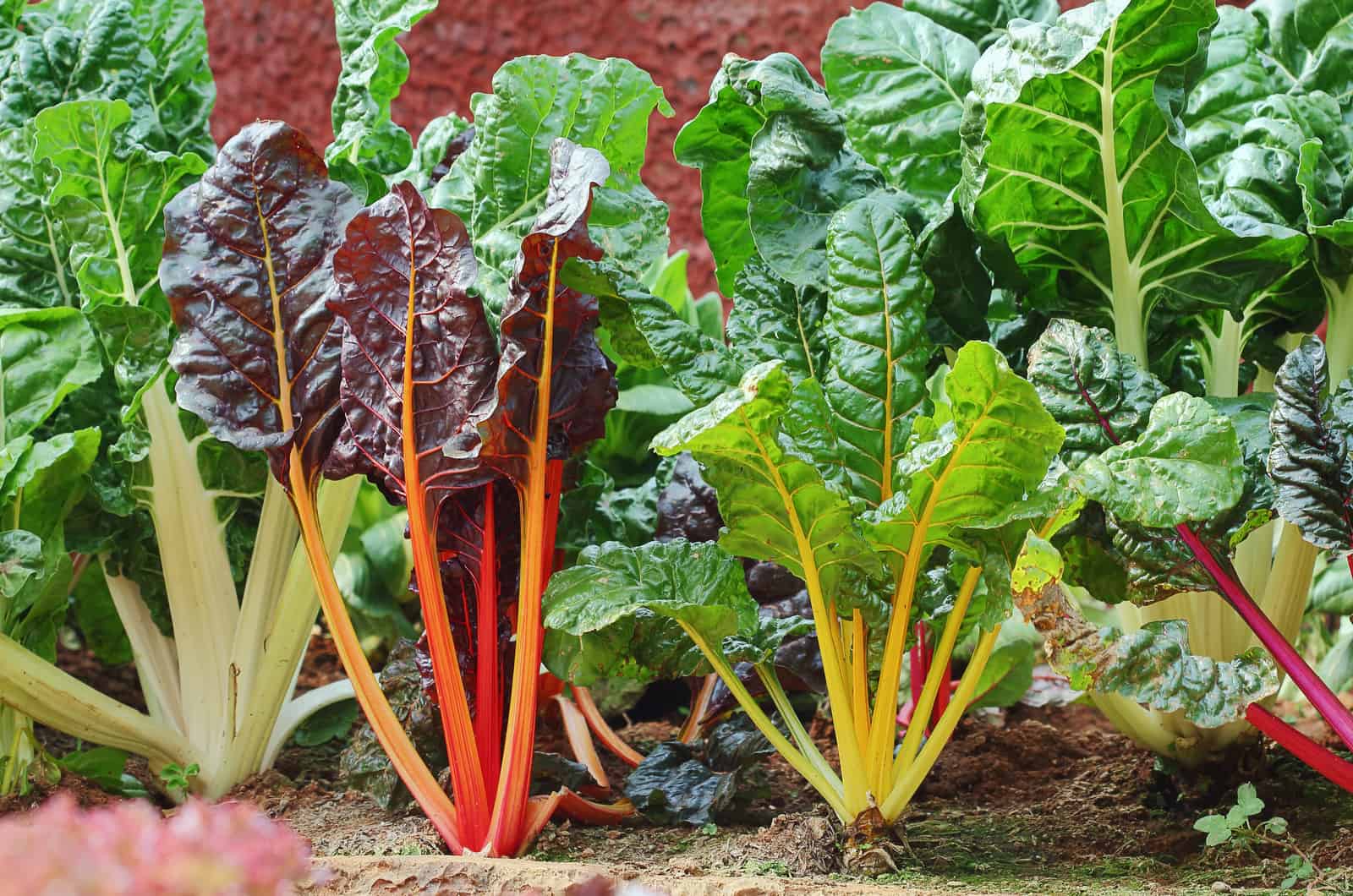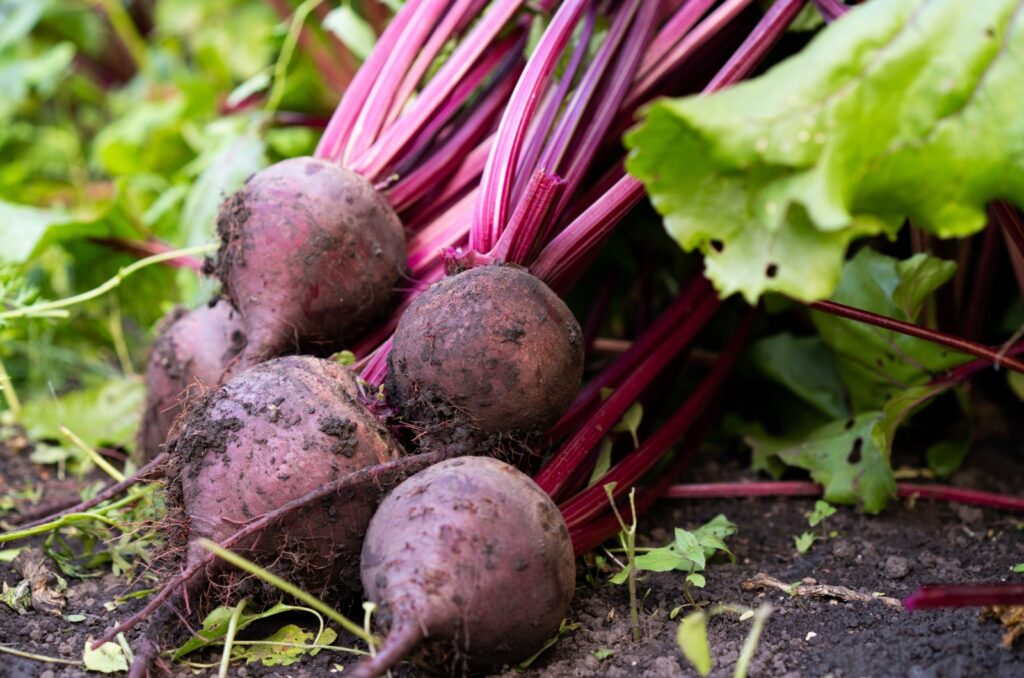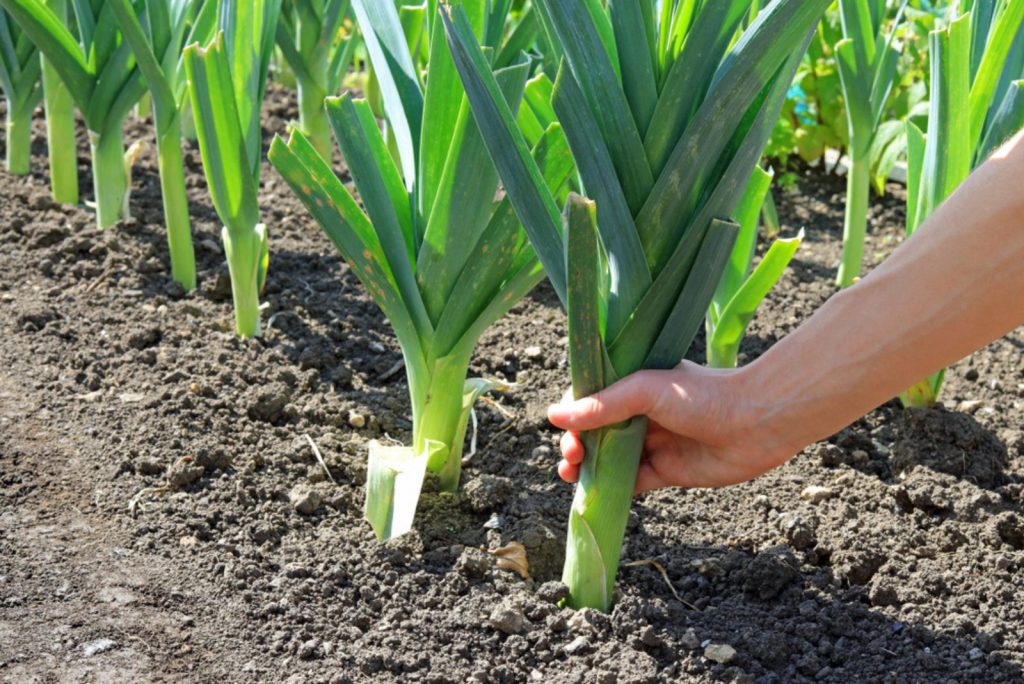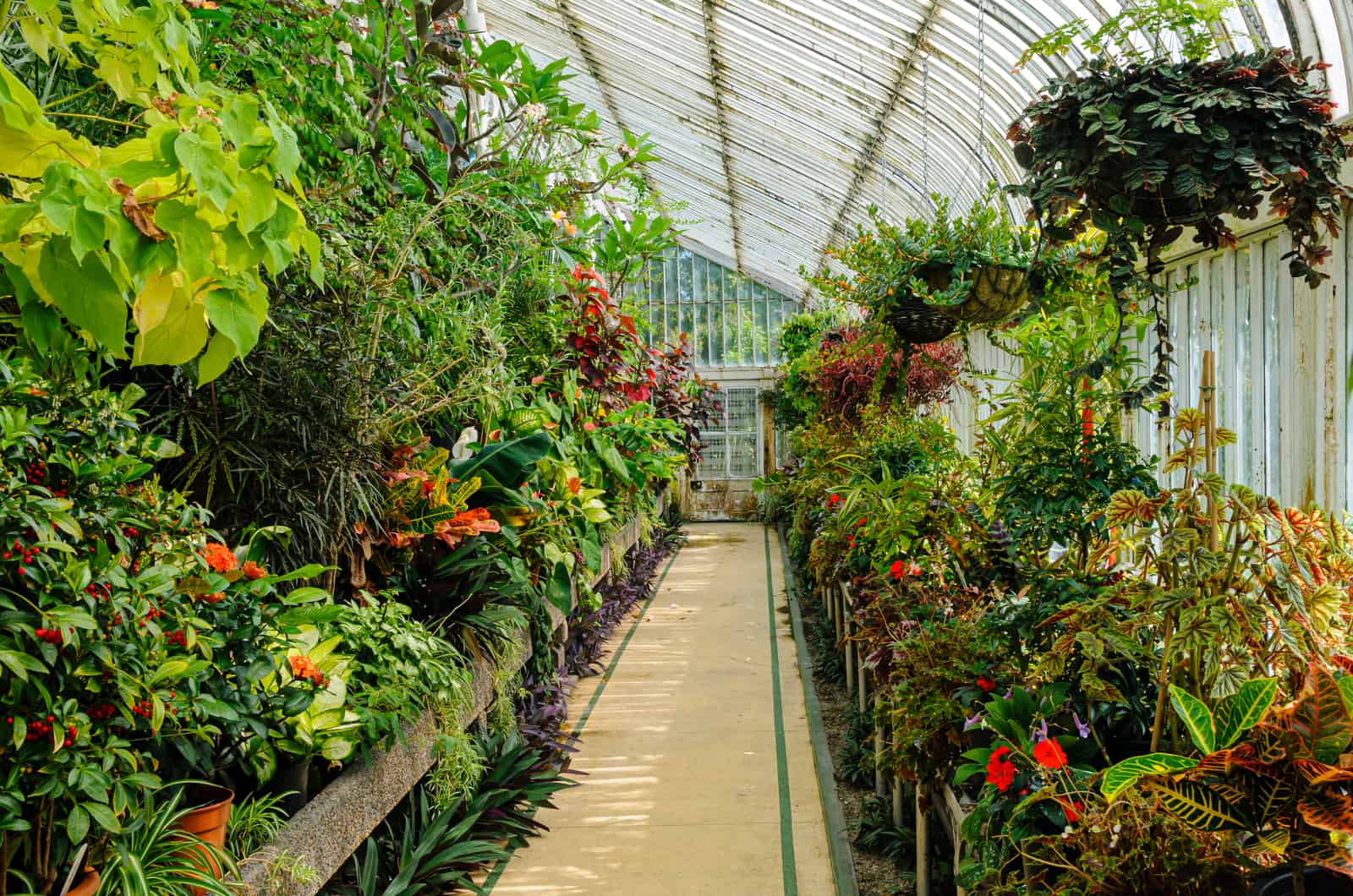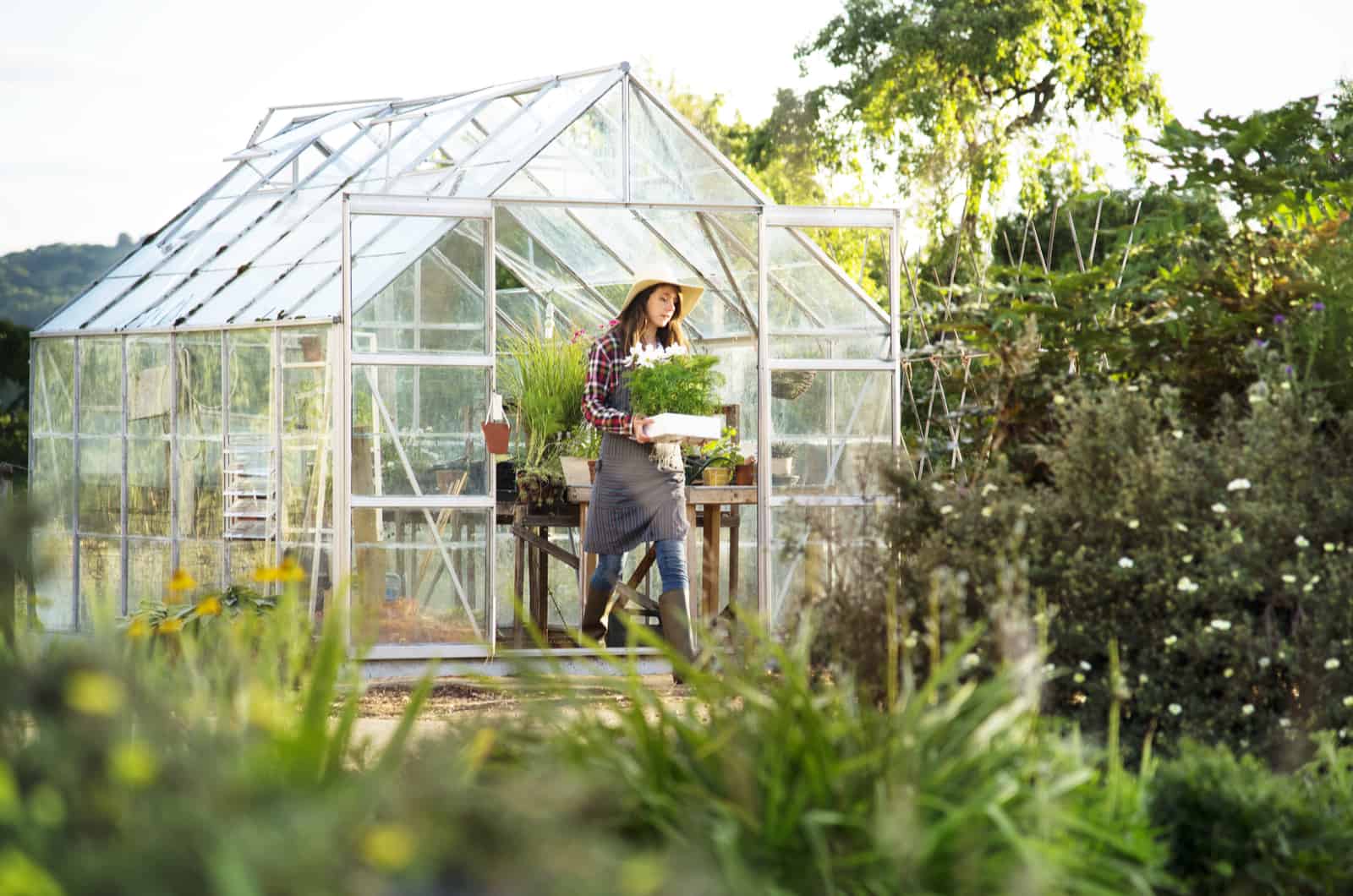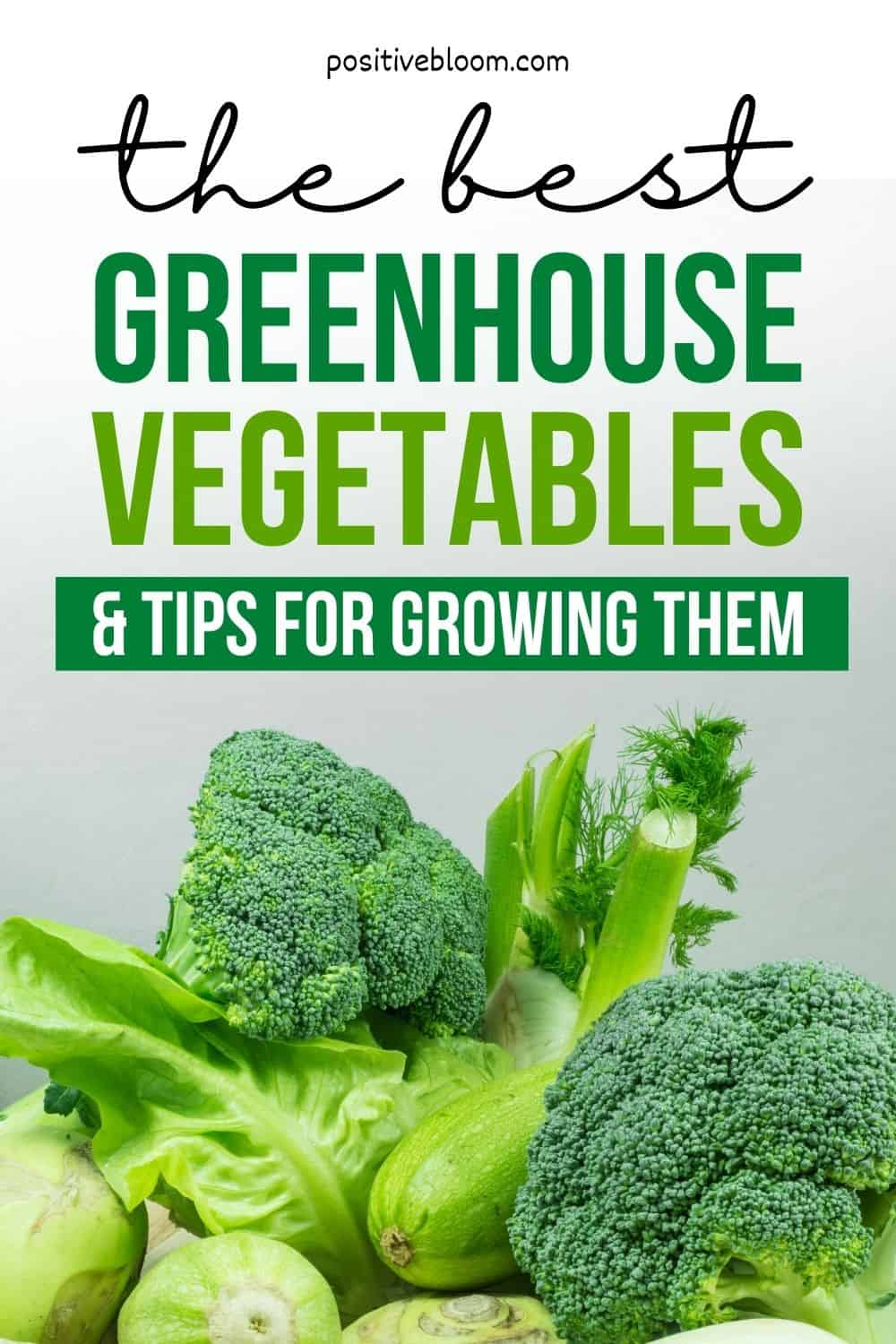If you’re into greenhouse gardening and have either already grown some plants, or are interested in starting, now is the perfect opportunity to find out the best greenhouse vegetables you can grow!
You can choose from many options depending on your taste or the conditions you can provide your plants. I’ll also give you tips for growing vegetables in a greenhouse.
There are a lot of beginner-friendly vegetables you can grow, but each needs different conditions. These conditions are mainly related to heat and ideal temperature.
I can’t wait to tell you everything, so let’s get started!
A List Of Greenhouse Vegetables
The list of veggies you can grow in a greenhouse is quite long, so it’s not hard to find the right one for you.
Let’s go through them one by one!
1. Cucumbers
There are two types of cucumbers: cucumber vines and bush cucumbers. If you grow vining varieties, you’ll need a trellis and a large greenhouse.
On the other hand, if you have a small greenhouse, bush cucumbers are a great choice. There are many bush varieties, like Burpless Bush Hybrid and Bush Crop, and I like these two because they’re great for pickling.
When To Plant
Plant cucumber seeds three weeks before planting them in the greenhouse. The best time would be in winter or early spring so the seeds germinate at 68°F.
If you have a heated greenhouse, plant the seeds in February or March, and if you have an unheated greenhouse, plant them in April.
Tips For Growing
Cucumbers enjoy high humidity and like to be watered regularly. Fertilize them once a week using a high potash fertilizer.
These veggies bear both female and male flowers, and the best thing would be to remove the male flowers to prevent the crops from tasting bitter and being full of seeds due to pollination. Never place cucumbers near yarrow plants as companions.
Health benefits
Cucumber plants are low in calories and high in nutrients, which makes them perfect for a healthy diet. They are a great water source and can help people lose weight and lower their blood sugar. Above all, cucumbers are a tasty treat!
2. Tomatoes
Tomatoes have the highest success rate when grown in greenhouses. As you may know, there are many tomato varieties, but the best ones to grow in greenhouses are Sweet Million, Sungold, Gardener’s Delight, and Cappricia.
When To Plant
Tomato seeds should be planted either six weeks before transplanting them to the greenhouse or before the last frost. This is usually in late April.
However, as they are grown in a greenhouse, you can plant the seeds in early April. If you ensure perfect growing conditions for your tomatoes, you can plant the seeds year-round in a greenhouse.
Tips For Growing
Tomatoes thrive in high temperatures, anywhere between 70 to 75 degrees Fahrenheit. Tomatoes need to be fertilized regularly, and compost is a great option. You can also add mulch to the soil to neutralize the compost. Alternatively, you can use a balanced triple 14 fertilizer.
Water them every two days, but always check if the soil is dry as tomatoes are sensitive to overwatering.
The difference between tomatoes and other veggies is that you’ll need to assist the pollination with your hands. Tomatoes are pollinated by the wind, and as there isn’t any wind in a greenhouse, you’ll have to do the job yourself.
Tomatoes can also be grown in a high tunnels set-up.
Health Benefits
Tomatoes reduce the risk of heart disease and cancer, and are rich in vitamins C and K.
They should always be included in a healthy diet- only you’ll have to remove lectins from tomatoes as the lectins aren’t considered healthy. They are part of my diet, even though I also use tomatoes in many unhealthy ways (I really like pizza!).
3. Arugula
Arugula is one of the leafy greens I absolutely love! It’s the salad green I use most regularly. You can find it going by many names, like rocket, rucoli, rucola, or roquette.
The great thing about arugula is that its young leaves can be harvested a couple of weeks after you sow the seeds.
There are many cultivars, like Rocket Arugula, Wall Rocket, and Red Dragon, and whichever you choose will serve you well. Try an Arugula Dijon Salad, and I guarantee you will want to grow some of your own!
When To Plant
You can sow Arugula seeds in early spring or late summer if you want to harvest your arugula in the fall. However, you can harvest this vegetable continuously if you sow the seeds every 2-3 weeks during the growing season. The seeds of these leafy greens will germinate in about a week.
Tips For Growing
This is a low-maintenance vegetable. It prefers well-draining and fertile soil with a pH ranging from 6.0 to 6.8. Arugulas appreciate moist soil, so don’t let the soil dry out entirely between waterings. Consider growing some companion plants for arugula to enhance growth.
Health Benefits
These veggies are rich in vitamins A, K, and C, but low in carbohydrates and sugar. They support our immune system and help maintain heart and kidney function.
Arugulas contain potassium, which is excellent for heart and nerve function.
4. Kale
If you want to grow vegetables for great salads, casseroles, and smoothies, then kale is a cultivar worth adding to your greenhouse! The good thing is that kale grows quickly in greenhouses if you mimic their natural habitat.
Varieties include Black Magic, Dazzling Blue, and Dwarf Siberian, among others.
Kale is great for cold frame greenhouses and can be grown throughout winter.
When To Plant
You can sow kale seeds from mid-July to August, or start transplanting from March to July if you want to plant them in April or August. Seeds need about ten days to germinate and transplants need about six weeks to grow.
Tips For Growing
You have to pay close attention to the temperature in your greenhouse if you grow kale as they are hardy plants and can’t withstand higher temperatures.
It may grow in high temperatures, but will taste bitter, grow slower, and produce low-quality crops, and you don’t want that.
Always keep about an inch of the topsoil moist, as these veggies are prone to overwatering.
Health Benefits
Kale is a superfood and supports the immune system, bones, and eye health. They help lower cholesterol, prevent heart disease, and promote weight loss.
5. Microgreens
Microgreens are very popular nowadays, and perfect for any greenhouse. I suggest you pick some easy varieties if you’re a beginner, like mustards and Santo.
When To Plant
Sow the microgreens seeds in early spring before the last expected frost in your area. The sprouts of microgreens (the first stage of their life cycle) can be eaten.
They are considered microgreens in their second stage (about two weeks old), and are harvested at this stage.
Tips For Growing
Use the seed coverage for planting cells to allow your microgreens to support each other and grow thick.
Heat the greenhouse or use heating pads for successful growth, and ensure the soil is constantly moist, but not soggy.
Apply bottom watering to prevent gray mold and damp.
Health Benefits
Microgreens lower the risks of heart and Alzheimer’s disease. They help reduce the risk of diabetes and various types of cancer.
6. Spinach
Spinach can be grown in greenhouses, containers, or raised beds. I grow it in my greenhouse as I like to harvest this tasty vegetable throughout the entire year. The spinach varieties in my garden are Palco and Melody as they are resistant to downy mildew.
When To Plant
You can plant spinach in late winter or early spring, and then wait until the hottest temperatures pass and plant again in late summer or early fall. You’ll need to use compost and keep it moist until the seeds germinate, which will take about 7 to 10 days.
Remember, you should always purchase new spinach seeds because they don’t age very well. The seeds in old packages are less likely to germinate.
Tips For Growing
Ensure you use well-rotted manure or compost if you’re growing spinach in greenhouse beds.
The soil’s pH level should range from 6.5 to 7.5, and you should choose a place in your greenhouse where the spinach can get a lot of sunlight. Partial shade can also work fine.
Place them in a cooler part of your greenhouse and ensure they have good ventilation.
It would be best to move your spinach containers to your garden in June and July as it won’t be possible to grow spinach in the greenhouse during these months.
Health Benefits
Spinach reduces blood sugar, prevents cancer, and is also good for eye and bone health. If you are trying to lose weight, spinach should be a part of your diet.
7. Cabbage
I mainly use cabbage for salads, but I’ve seen it used in many different world cuisines. When I tried some, it made me want to grow cabbage in my greenhouse.
Common names for cabbage are headed cabbage and Brassica Oleracea. You can grow them in the winter months and you won’t need to overheat the greenhouse.
If you want cabbage vegetable crops within 50 days, choose Parel, Rubicon, or Fast Ball varieties.
When To Plant
If you want to harvest cabbage in the winter, plant it in late summer or seven weeks before the first frost.
Keep the temperature around 65°F to promote germination, add a thick layer of mulch, and check the moisture regularly.
If you don’t want to heat your greenhouse, cover young seedlings in the evening with horticultural fleece or some DIY version for covering.
Tips For Growing
The first thing you should know about cabbage is that it depletes the soil of nutrients, so it shouldn’t be planted next to other plants.
However, you can plant cabbage near some dill, as the dill attracts wasps which eliminate worms that could potentially kill the cabbage.
Another good plant to grow near cabbage is beans, which enrich the soil with Natrium. You can also grow herbs like cilantro near your cabbage.
Don’t let the temperature go over 80°F as it will encourage the cabbage to produce flowers, which will give it a bitter taste.
Health Benefits
Brassica Oleracea reduces the risks of cancer and heart disease, but also promotes good metabolism. Additionally, it’s rich in vitamin C and improves digestion. Red cabbage regulates blood sugar and reduces cholesterol.
8. Salad Greens
You can choose from many different salad greens for your greenhouse. For example, romaine lettuce or beet leaf are both greenhouse-loving plants.
I hate it when I’m at a restaurant and salad greens are only used for decoration! There’s so much more potential for these wonderful greens.
When To Plant
It’s essential to purchase a few different types of seeds if you want to harvest salad greens throughout the whole year. For the start, I suggest you choose varieties that grow well in cool weather, like Lamb’s Lettuce, and in summer go for heat-resistant salad greens like Jericho Romaine Lettuce.
Sow the seeds gradually. For example, sow at least three seeds every week, let them grow for a couple of weeks before you plant them, and use a grow light to promote their growth.
Salad greens will grow again after the harvest if you leave about an inch of the plant above the ground.
Tips For Growing
Ensure loamy soil rich in organic matter. Water these vegetables regularly as they are shallow-rooted and grow fast and inadequate watering can cause the salad to taste bitter. Adjust the temperature to anywhere between 50 and 70 degrees Fahrenheit during the day.
Health Benefits
Salad greens reduce cholesterol and are low in calories, which makes them perfect for everyday eating. When I make a salad, I always use less dressing as I want to enjoy the taste more, which you should definitely try!
9. Broccoli
I wasn’t a fan of broccoli when I was a kid, and I assume many other kids have felt the same way. Over time, I realized how beneficial this vegetable is, so I tried growing it in my greenhouse. Surprisingly, I got my broccoli really fast!
Destiny, Romanesco, Eastern Magic, and Sun King are the most common varieties.
When To Plant
Sow broccoli seedlings in winter, but avoid sowing them in spring.
You should sow broccoli seeds about 1/2 inch deep and wait for five weeks to transplant them.
If you want to store some broccoli, bear in mind that you’ll need more plants to have enough for storage.
Tips For Growing
Broccoli is a heavy feeder and needs to be fertilized regularly. I suggest using compost as a fertilizer, but compost tea and organic fertilizer will do very well (the one’s used for raspberries will be great).
Water these veggies thoroughly once a week as light watering won’t keep the soil moist for long enough.
You can plant them in an outdoor garden bed when your broccoli is about 5 inches high and has five true leaves.
Health Benefits
Broccoli reduces heart disease and the risk of cancer. It also promotes eye health and hormonal balance. If you eat broccoli regularly, it can help prevent various infections.
Broccoli is an incredibly tasty vegetable! Try caramelized broccoli with garlic if you don’t believe me!
10. Bell Peppers
The majority of growers who plant bell peppers in their greenhouses claim to have had a great experience, and I am one of them.
If you want to harvest a good amount of bell peppers, grow them in a container or raised beds within the greenhouse.
Many say that red bell peppers taste the best, but I can’t decide as I like them all! The best varieties of sweet peppers to grow in your greenhouse are Bell Boy and California Wonder.
When To Plant
Bell peppers grow during warmer seasons, so the best time to sow the seeds is from mid-February to early April.
For successful germination, keep the temperature between 65 and 70°F. I suggest you also add sowing compost to get the best results.
Tips For Growing
Bell peppers thrive in well-draining loamy soil. Watering needs differ for each growing stage. For example, these plants don’t need much water during the early stages when they are forming their roots. The roots will search for moisture deep in the soil, causing rapid growth.
Add compost to enrich the soil and promote bell pepper plant growth.
Health Benefits
Bell peppers are rich in vitamin C, which improves iron uptake and prevents anemia. These vegetables reduce the risk of both heart and Alzheimer’s disease.
11. Radish
When I started growing vegetables in my greenhouse, I wondered if greenhouse growing was suitable for the radish. I tried growing them, and I got great results!
The best varieties to grow in your greenhouse are White Icicle, Sparkler, and Cherry Belle.
When To Plant
You should sow radish seeds from April through early May, then pause before continuing in August. These are cold-resistant vegetables that won’t tolerate drought. However, you must avoid overwatering the soil to prevent the seeds from emerging.
Tips For Growing
Radishes appreciate fertilizers rich in nitrogen. Use a bone meal if you decide to fertilize the seeds before sowing them.
Radishes thrive in good sunlight, so avoid the shade if you want more crops.
These make for great companion plants, so if you are growing bell peppers you should also plant radishes to repel aphids.
Health Benefits
Radish plants are rich in potassium and calcium, help lower blood sugar, and reduce the risk of heart disease.
If you want to avoid foods rich in carbohydrates and sugar, these plants should be a part of your regular diet. Radishes indeed have many health benefits.
12. Eggplant
If you have ever tried fried eggplant then you know exactly why you should grow them! The great news is that you can grow eggplants in your greenhouse. Trust me, you won’t regret it.
The most common varieties are Diamond, Black Beauty, and Rosa Bianca.
When To Plant
If you sow eggplant seeds in early March, the plant will have more time to mature and produce crops.
One eggplant can produce about seven fruits, so make a plan before sowing as you don’t want too many eggplants taking space away from your other plants.
Tips For Growing
Eggplants thrive in full sun, so be careful when choosing a location for them in the greenhouse. Remember, they won’t grow well in the shade.
Eggplants need support as they are pretty heavy, so prepare something like a bamboo cane to reduce the risk of leaning.
If you want your eggplants to thrive, plant them in raised beds and add a lot of composted manure.
Health Benefits
Eggplant is great because it contains vitamins C and A, which protect cells from damage, and polyphenols that help cells process sugar. This is great if you have diabetes.
Ancient Indians used eggplant roots to cure asthma.
13. Turnips
If you want to grow cool-weather veggies in your greenhouse, turnips are a great option. Both the roots and greens are edible, making this fast-growing plant even more attractive.
Purple-Top White Globe, Scarlet Queen, and Baby Bunch turnips are the most common varieties.
When To Plant
If you want to harvest turnips in late spring, sow the seeds three weeks before the last spring frost.
If you’d prefer to harvest your turnips in the fall, sow the seeds late summer.
You can also get crops in late fall if you sow the seeds in early fall. The turnip seeds can be planted directly into the soil and should germinate within a few days.
Tips For Growing
Turnips are sensitive to weeds, so mulch heavily to suppress their growth.
The soil should always be moist, so water an inch a week. If you stick to this watering schedule, you’ll prevent the roots from tasting bitter.
Avoid fertilizers rich in nitrogen. I suggest 5-5-5 organic fertilizers.
Turnip plants thrive in temperature ranging from 40° to 75°F.
Health Benefits
Turnips contain glucosinolates, which help prevent all kinds of cancer. These plants will also keep your eyes and bones healthy as they are rich in calcium.
You can make delicious and healthy salads with raw turnips.
14. Okra
Okras are one of the best vegetables to grow in a greenhouse! They are also known as ladyfingers and are native to southern parts of the US, which is great as they enjoy warm environments.
Okras are easy to grow, tasty, and also look very attractive due to their beautiful flowers.
Cow Horn, Emerald, Go Big, and Louisiana Green Velvet are the most common varieties.
When To Plant
The best time to plant okras is in spring, about three weeks after the last frost. If you want to get crops earlier, sow the seeds in black pots and keep a high temperature in your greenhouse.
The temperature range for successful germination is 65 to 70 degrees Fahrenheit.
Tips For Growing
The perfect soil for okras is well-draining and fertile. These plants thrive in full sun and partial shade, making them ideal for growing in a greenhouse.
If the temperature gets too low, okras will be susceptible to pests and diseases, even if it’s only cold for a short period.
Water your okras an inch a week.
Health Benefits
Okras improve heart health and help kill cancer cells. They may also prevent liver disease and improve eyesight.
Okras are rich in calcium and magnesium, and can prevent their deficiency.
15. Zucchini
Zucchini are an excellent choice for beginner gardeners as they are the simplest vegetables to grow in general. You can harvest zucchini in less than three weeks.
You can even grow zucchini year-round if you ensure the necessary conditions.
The most common varieties are Ronde de Nice (baby round zucchini) and Partenon.
When To Plant
Zucchini is a warmth-loving plant, so the best idea would be to plant it in early summer. They are cold-intolerant and won’t grow if the temperature is below 70 degrees Fahrenheit.
You can expect crops in just 50 days!
Tips For Growing
Ensure it has well-draining, loamy, and fertile soil. Fertilize your zucchini once a week by adding a handful of compost.
Zucchini plants have both male and female flowers, so they need proper airflow and beneficial insects for pollination. You can keep vents open or pollinate manually.
If you don’t have a hydroponic system installed, water every day or every two days. Alternatively, you can install a drip irrigation system.
Health Benefits
Zucchini improves eye health and helps control blood circulation. It will increase your energy as it’s rich in folates.
This plant is low in calories and has high water content, so it may help with weight loss.
16. Green Onions
Can you think of a meal that wouldn’t taste better with green onions? I certainly can’t! Although there can be tears when cutting them, green onions are invaluable for certain dishes.
Many growers claim that these are almost maintenance-free vegetables, and I agree with them.
The most common green onion varieties are Crystal White, Wax Evergreen Long White, and Tokyo Long White.
Green onions are also called scallions in some places, remember that!
When To Plant
Green onions should be planted from mid-March to mid-April. You can plant green onions from both seeds and sets.
I suggest you grow green onions from sets if you want to get a lot of crops without installing heaters.
Tips For Growing
Green onions should be watered regularly, especially during hot weather. Once the foliage turns yellow and dies back, it’s time to uproot the onions.
Leave your green onions in full sun to dry well before storing them – it doesn’t get much simpler than this!
Health Benefits
Green onions improve bone health and reduce the risk of cancer. They lower blood pressure, aid in weight loss, and help control diabetes.
17. Carrots
Carrot cake, anyone? No? Just me then!
Carrots are frost tolerant root vegetables.
The best carrot varieties include Chantenay Carrots, Rondo, and Early French Frame.
Carrots are a perfect choice for your vegetable garden.
When To Plant
You can sow carrot seeds from early spring to late August if you want to harvest year-round.
Some early carrot cultivars like Nantes 2 can be sown from February.
The carrot seeds will germinate in one to three weeks if you provide them with a temperature between 68 and 86 degrees Fahrenheit.
Cover the seeds with vermiculite or mulch during germination.
Tips For Growing
Keep the soil moist, but not soggy during all carrot growing stages. The soil shouldn’t be dry as this will kill the seeds.
The soil should be loose, deeply tilled, and sandy.
Never pull the carrots when harvesting them as you’ll only end up with the leaves! Use a garden fork to loosen the soil before harvesting.
Health Benefits
You must have heard that carrots help you see in the dark, and it’s partially true as carrots contain beta-carotenes, which are good for eye health.
They’re great for skin and aging, improve the immune system, and support the respiratory system.
Carrots reduce the risk of cancer, support gut health, and help in weight loss.
18. Asparagus
If you want a vegetable that can produce for 20 years, look no further than asparagus! If you plant 20 asparagus crowns, you’ll get enough crops for three households.
Keep asparagus away from other plants as they won’t grow well. Even though the first harvest may not result in many crops, the next season will certainly surprise you, so don’t worry.
Conover’s Colossal, Erasmus, Grande Hybrid, and Jersey Giant are the most common asparagus varieties.
When To Plant
Sow asparagus seeds from mid-February to May. Keep the temperature between 70 and 85 degrees Fahrenheit until they germinate.
It can take between two to eight weeks for asparagus seeds to sprout. Transplant the seedlings after the frost ends.
Here’s a video:
Tips For Growing
Asparagus appreciates well-draining soil with a pH ranging from 6.5 to 7.0.
Apply 10-10-10 fertilizer occasionally for optimum results.
These plants have deep root systems so pay attention to watering. If the soil is waterlogged, the roots will quickly rot.
Health Benefits
Asparagus improves the digestion system and reduces liver damage. It’s rich in folates, which helps with cell division.
Asparagus is known to have anti-inflammatory effects and lower blood pressure.
19. Swiss Chard
Swiss chard can be grown throughout the year, is easy to cultivate, and super tasty!
It’s never too late to start growing swiss chard, so if you have a greenhouse you can head out right after reading this article!
The most common swiss chard varieties include Barese, Bright Lights, and Fordhook Giant.
When To Plant
Swiss chard seeds should be planted directly into the soil from early spring to mid-summer.
The seeds need temperatures from 50 to 85 degrees Fahrenheit in order to germinate. You can expect your swiss chard seeds to sprout in 7-14 days.
Tips For Growing
Ensure well-draining, loose, and fertile soil rich in organic matter. Find a sunny spot in your greenhouse to plant your swiss chard plant.
Apply liquid fertilizer or compost tea twice during the summer.
The best companions for swiss chard are beans, onions, and brassicas.
Health Benefits
Swiss chard is rich in vitamins A and K, which improve heart, lung, and kidney health.
These plants are great for immune function, reproduction, and vision. They are also rich in vitamin C, which aids in iron absorption and improves teeth and bone health.
20. Beets
Beets are one of the easiest and fastest-growing vegetables you can grow in a greenhouse. Their deep red roots are packed with nutrients, and their leafy greens are just as delicious and nutritious! If you’re looking for a versatile crop, beets are a fantastic choice.
Some of the best varieties for greenhouse growing include Detroit Dark Red, Golden Beet, and Chioggia, known for their unique striped interior.
When To Plant
You can plant beets in early spring or late summer for a continuous harvest. Since they’re a cool-season crop, they thrive in greenhouses, allowing you to extend your growing season. Sow beet seeds directly into the soil, and they’ll germinate in about 5-10 days.
Tips For Growing
Beets thrive in loose, well-draining soil with a neutral pH of 6.0-7.0. Water them regularly but avoid overwatering, as soggy soil can cause the roots to rot. To ensure even growth, thin out seedlings once they’re a few inches tall, leaving about 3 inches between each plant.
If you want sweeter beets, keep them in a cooler part of the greenhouse, as high temperatures can cause them to develop a more earthy taste.
Health Benefits
Beets are loaded with antioxidants, fiber, and essential vitamins like B9, which support heart health. They can help lower blood pressure, improve endurance, and even aid digestion. Plus, they’re a great natural energy booster, making them a powerhouse veggie to add to your diet!
21. Leeks
Leeks are an underrated greenhouse crop that adds incredible flavor to soups, stews, and other dishes. Their mild, onion-like taste makes them a staple in many kitchens, and they’re surprisingly easy to grow.
Some excellent varieties to try include King Richard, Bandit, and Giant Musselburgh, known for their thick, tender stems.
When To Plant
Start leeks from seed in late winter or early spring for an early summer harvest. If you’re looking for a fall or winter crop, plant them in late summer. They take a bit longer to mature, but once established, they thrive in greenhouse conditions.
Tips For Growing
Leeks prefer well-draining soil rich in organic matter. Water them consistently, but don’t let the soil become waterlogged. For long, white stems, hill up soil around the base of the plant as it grows. This blanching technique keeps the stalks tender and flavorful.
They don’t require much maintenance, but adding compost or a balanced fertilizer will encourage faster growth and a more robust harvest.
Health Benefits
Leeks are packed with vitamins A, C, and K, supporting immune health and reducing inflammation. They’re also high in fiber and prebiotics, promoting gut health and digestion. Plus, their mild, sweet flavor makes them an easy addition to countless dishes!
FAQs
What are the advantages of growing vegetables in a greenhouse?
If you grow vegetables in a greenhouse you can get off-season varieties. Many animals that would otherwise try to eat your vegetables can be kept away. Fewer people will be in close contact with the plants, which decreases the chances of different diseases.
What is the most common type of greenhouse?
Some common types of greenhouse are A-frame greenhouses, gable-roofed greenhouses, the gothic arch, a lean-to greenhouse, and a shade house.
Wrapping Up
The list of various greenhouse vegetables may be long, but that’s a positive as you have so many options.
The great thing about greenhouses is that you can control the environment within them and grow off-season vegetables.
Now that you know the vegetables that can be grown in a greenhouse, why don’t you try growing some of your own?
Until next time!
Like this post? Share or pin it for later!

